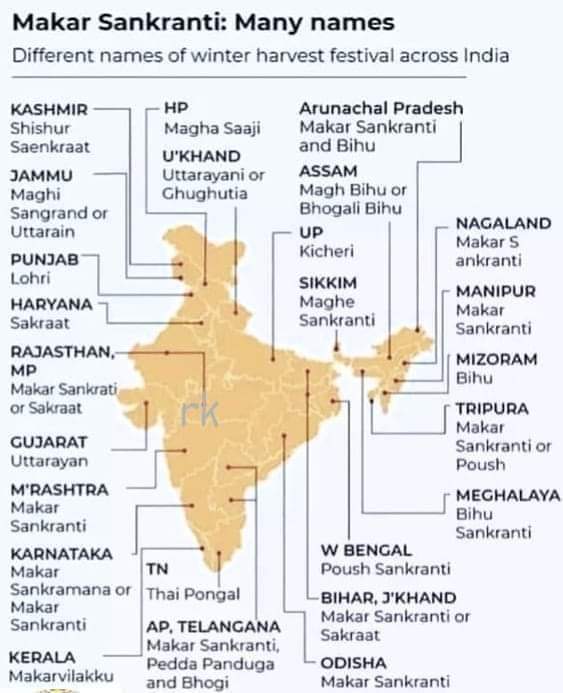There are twelve sankrantis in a year. These are-
- Makar (uttrayan, winter solstice, ayanअयन )
- Kumbh (vishnupadi विष्णुपदी sankranti)
- Meen (Shadshitimukhi (षड्शिती मुखी) Sankranti)
- Mesha(solar new year, vishuva विषुव or सम्पात sampat sankranti)
- Vrishabh (vishnupadi विष्णुपदी sankranti)
- Mithun (Shadshitimukhi (षड्शिती मुखी) Sankranti)
- Kark (dakshinayan, summer solstice, ayanअयन )
- Simha (vishnupadi विष्णुपदी sankranti)
- Kanya(vishwakarma pooja, Shadshitimukhi (षड्शिती मुखी) Sankranti)
- Tula (vishuva विषुव or सम्पात sampat sankranti)
- Vrishchika (vishnupadi विष्णुपदी sankranti)
- Dhanu (Shadshitimukhi (षड्शिती मुखी) Sankranti)
Makar Sankranti ( Udgaayana, Devyaan) festival is dedicated to Surya Bhagwan. Charity/ Daan is a very important part of this festival.
Makar sankranti festival has many aspects associated with it like religious, social, spiritual, scientific, agrarian, etc. Date of this festival is calculated with solar calender ( many festivals in India are based on Lunar calender).
Legends associated with Makar Sankranti:
- Sun visits his son Shani in Makar(Capricon) Nakshatra.
- Ganga came on earth.
- Bhism Pitamah left his body (after 56 days).
- Magh mela.
- Prayag mela.
- Kumbh mela started on this day.
- Beginning of harvest season- Til and Rabi.रबी की फ़सल सामान्यतः अक्तूबर-नवम्बर के महिनों में बोई जाती हैं। इन फसलों की बुआई के समय कम तापमान तथा पकते समय खुश्क और गर्म वातावरण की आवश्यकता होती है। उदाहरण के तौर पर गेहूँ, जौ,आलू, चना, मसूर, अलसी, मटर व सरसों रबी की प्रमुख फसलें मानी जाती हैं।
- Beginning of financial season.
- Kite festival.
Festivals similar to Makar Sankranti:
- Ring Sanctuary of Pömmelte (or ‘Germany’s Stonehenge’), made of wood ( Wood circle of Germany)--Evidence from recent excavations at the Pömmelte enclosure suggests that, like other circular or henge-like enclosures, it may have been a place for communal gatherings, ritual activities and performance, with significant solar alignments. Wood circle was a festival celebrating winter solstice.
- Stonehenge, England- stones are alligned with sunrise on the shortest day of the year.
- Many stonehenges all over the Europe, Indonesia, America, Japan.
- Asota Sharif (Kalula) Stone Circle in Pakistan.
- Yule festival- The Yule tree symbolizes the earth's axis, pointing to the pole star.
- Megaliths in India- Punkree Burwadiht in Jharkhand. The megalithic temple is placed on a mound. Two menhirs here are placed so accurately that a “V” form is obtained and it is through this V the sunrises can be witnessed. Nilurallu stone circle in Andhra Pradesh.
Makar sankranti is celebrated in almost every part of India. People call it by different names and celebrate it in various ways.
Tamil Nadu:
It is a four day festival.
First day is Bhogi Pandiga- on this day people burn old things.
Second day- Thai pongal- Boil rice and sweets and throw these towards Sun.
Third day- Mattu pongal- Decorate cattles, bull
Fourth day- Kanu pongal- visit relatives.
Karnataka:
Harvest festival- Suggy
Pongal Huggi
Ellu Bella- til, gur
Ellu Beerodu
Kichuchu Haisodu
Kerala:
Makara Jyoti
Makara villalu(lantern)
Ayyapa manifests on this day
Andhra Pradesh and Telangana:
4 days festival-
first day- Bhogi
Second day- Pedda Panduga
Third day- Kanuma
Fourth day- Mukkanuna
Kodipandem- rooster fights
Kite festival
Maharastra:
Til Gur
Til gul ghya, aani god god bola
Haldi Kumkum
People wear black color-- Sun forgave Shani on this day. Black is color of Shani so people wear black. Other story is that in Paniipat war, when Marathas lost the battle and many females became widow, they chose this color to respect the sacrifice made by Maratha males and females.
Odissa:
Makar mela
Celebrations in Konark(Sun) and Jagannath temples.
Makara Basma- Bonds of friendship
Rajasthan and Madhya Pradesh:
Sankrant
People give gifts to 13 or 14 married females, elders, temples, needy, etc.
Pheeni, gajak
Sankrant Bhoj
Kite festival
Utter Pradesh and Uttrakhand:
Ganga mela
Khichri sangrand
Uttrayani mela
Khichdi
Offerings are made to birds(crows)
Gujarat:
Uttrayan
Undhiyu food
International kite festival
Punjab:
Maghi
Sesami oil lamps
Bhangra, Giddha
Magh mela
Kheer and sugar cane juice
Previous day is Lohri
Sacrifice of 40 sikhs against invaders who were trying to capture Guru Gobind singh
West Bengal:
Paush Sankrant
Paush Porbon- Harvest festival
Khejuror gur- paddy and date palm syrup
three days of Lakshmi pooja
Darjeeling-
Magay sankranti
Ganga sagar mela
Assam:
Magh bihu
People make huts with bamboo and thatch, celebrate and then burn the huts next morning.
Shunga pitha, Til Pitha
Buffalo fighting
Tripura- Hangrai
Jammu and Kashmir- Uttrain
Following are Whatsapp forwards:
-
"मकर संक्रांति का महत्व"
हिंदू धर्म ने माह को दो भागों में बाँटा है- कृष्ण पक्ष और शुक्ल पक्ष। इसी तरह वर्ष को भी दो भागों में बाँट रखा है। पहला उत्तरायण और दूसरा दक्षिणायण। उक्त दो अयन को मिलाकर एक वर्ष होता है। मकर संक्रांति के दिन सूर्य पृथ्वी की परिक्रमा करने की दिशा बदलते हुए थोड़ा उत्तर की ओर ढलता जाता है,इसलिए इस काल को उत्तरायण कहते हैं। सूर्य पर आधारित हिंदू धर्म में मकर संक्रांति का बहुत महत्व माना गया है। वेदऔर पुराणों में भी इस दिन का विशेष उल्लेख मिलता है। होली,दीपावली,दुर्गोत्सव, शिवरात्रि और अन्य कई त्योहार जहाँ विशेष कथा पर आधारित हैं, वहीं मकर संक्रांति खगोलीय घटना है, जिस से जड़ और चेतन की दशा और दिशा तय होती है। मकर संक्रांति का महत्व हिंदू धर्मावलंबियों के लिए वैसा ही है जैसे वृक्षों में पीपल, हाथियों में ऐरावत और पहाड़ों में हिमालय। सूर्य के धनु से मकर राशि में प्रवेश को उत्तरायण माना जाता है। इस राशि परिवर्तन के समय को ही मकर संक्रांति कहते हैं। यही एकमात्र पर्व है जिसे समूचे भारत में मनाया जाता है, चाहे इसका नाम प्रत्येक प्रांत में अलग-अलग हो और इसे मनाने के तरीके भी भिन्न भिन्न हों, किंतु यह बहुत ही महत्व का पर्व है। इसी दिन से हमारी धरती एक नए वर्ष में और सूर्य एक नई गति में प्रवेश करता है। वैसे वैज्ञानिक कहते हैं कि २१ मार्च को धरती सूर्य का एक चक्कर पूर्ण कर लेती है तो इस मान ने नववर्ष तभी मनाया जाना चाहिए। इसी २१ मार्च के आसपास ही विक्रम संवत का नववर्ष शुरू होता है और गुड़ी पड़वा मनाया जाता है, किंतु मकरसंक्रांति ऐसा दिन है,जबकि धरती पर अच्छे दिन की शुरुआत होती है। ऐसा इसलिए कि सूर्य दक्षिण के बजाय अब उत्तर को गमन करने लग जाता है। जब तक सूर्य पूर्व से दक्षिण की ओर गमन करता है तब तक उसकी किरणों का असर खराब माना गया है, लेकिन जब वह पूर्व से उत्तर की ओर गमन करते लगता है तब उसकी किरणें सेहत और शांति को बढ़ाती हैं। मकर संक्रांति के दिन ही पवित्र गंगा नदी का धरती पर अवतरण हुआ था। महाभारत में पितामह भीष्म ने सूर्य के उत्तरायण होने पर ही स्वेच्छा से शरीर का परित्याग किया था क्योंकि उत्तरायण में देह छोड़ने वाली आत्माएँ या तो कुछ काल के लिए देवलोक में चली जाती हैं या पुनर्जन्म के चक्र से उन्हें छुटकारा मिल जाता है। दक्षिणायण में देह छोड़ने पर बहुत काल तक आत्मा को अंधकार का सामना करना पड़ सकता है। सब कुछ प्रकृति के नियम के तहत है, इसलिए सभी कुछ प्रकृतिबद्ध है। पौधा प्रकाश में अच्छे से खिलता है, अंधकार में सिकूड़ भी सकता है। इसीलिए मृत्यु हो तो प्रकाश में हो ताकि साफ-साफ दिखाई दे कि हमारी गति और स्थिति क्या है? क्या हम इसमें सुधार कर सकते हैं? क्या हमारे लिए उपयुक्त चयन का मौका है? स्वयं भगवान श्रीकृष्ण ने भी उत्तरायण का महत्व बताते हुए गीता में कहा है कि उत्तरायण के छह मास के शुभ काल में, जब सूर्यदेव उत्तरायण होते हैं और पृथ्वी प्रकाशमय रहती है तो इस प्रकाश में शरीर का परित्याग करने से व्यक्ति का पुनर्जन्म नहीं होता, ऐसे लोग ब्रह्म को प्राप्त हैं। इसके विपरीत सूर्य के दक्षिणायण होने पर पृथ्वी अंधकारमय होती है और इस अंधकार में शरीर त्याग करने पर पुनः जन्म लेना पड़ता है। 🙏मकर संक्रांति की अनेक शुभकामनाएं🙏
-
Makar Sankranti 15 Jan denoting civilizational sidereal calendar's enormity
Why has Makar Sankranti moved to 15 January from 14th in just a few years?
From 1935 to 2008 14 Jan From 2008 to 2080 15 Jan From 2080 to 2153 16 Jan From 2153 to 2223 17 Jan From 2223 to 2297 18 Jan From 2297 to 2369 19 Jan From 2369 to 2441 20 Jan From 2441 to 2513 21 Jan From 2513 to 2585 22 Dec Dhanu Sankranti
During 1857 war it fell on 12 Jan During 1761 Panipat battle it fell on 10 Jan!
The date Sun enters Makar (Capricorn) constellation is the date Sankranti is celebrated. Actually the western solar calendar is off by one day every 72 years due to earth's precession around the Sun. This is reason why the date moves forward when compared with the less accurate western calendar.
What is however important to note is that the Sun entering Capricorn per se is not important, but the day getting longer and warmer. This is called Uttarayan उत्तरायण.
What is interesting is that what happens after the year 2513 CE/AD?
From the year 2585CE onwards for the next 2160 years, that is till 4673CE उत्तरायण will be marked with धनु संक्रांति and not Makar Sankranti!
Hence in the year 2513 Uttarayan will be reset to from Makar Sankranti to Dhanu Sankranti and the date will move back one month to 22 December
https://www.omraizada.com/home/ugadi
https://www.omraizada.com/home/lohri
Jayasree Saranath:
A verse in Brihad Samhita says (Ch 3- 4) that if the sun commences its northward movement (Uttarayana) before reaching Makara (Capricorn) it would bring evil on the west and south. Similarly if it turns towards south (Dakshinayana) before it reaches Kataka (Cancer), it would cause harm to east and north. What this conveys is that it was well within the knowledge of the rishis that the movement (ayana) is not constant and cannot synchronise with Makara or Kataka at all times. It must have taken not just a few hundred but thousands of years of observation of the movement of the Ayanas (of the sun) and the terrestrial events related to the movement.
Today Uttarayana starts before the sun reaches Makara – the same condition mentioned in Brihad samhita. Interestingly no text speaks about Uttarayana after it slipped south of Makara that is in Dhanus (Sagittarius) which had happened more than 1500 years ago. The last time we hear about the conjunction of Makar Sankaranti and Uttarayana is from Varahamihira. After that the next reference – plenty of them are there - comes in the inscriptions of1000 years before present. Interestingly they refer to “Uttarayana Sankaranti” and the dates concur with Makara Sankaranti only and not the actual date of Uttarayana (sun turning towards north after it reaches the southernmost point). That means Uttarayana to the south of Makara was never recognised for rituals and instead it was combined with Makara Sankaranti – on the date the sun enters Makara.
It is here the problem of non-synchronous synchrony between the two has been taken up by modern researchers who think that we are wrong in having “Uttarayana Sankaranti”. They insist that Uttarayana must be recognised at the current location of northward movement and adjust the dates of the festivals accordingly.
But the fact is that tropical solstice or Equinox do not determine the festivals or rituals of the Vedic society. Only the sun and moon as Panchānga factors are reckoned for fixing the dates of festivals. Today vernal equinox starts at 6 degrees of Pisces and modern reformers want us to start Aries at that point. This is nothing but lack of domain knowledge of Vedic astronomy – for, the month of Chaitra (Aries) is determined by the full moon happening in Chitra star, but it does not happen so when the sign of Aries starts with the Sun in 6th degree of Pisces. Vedic astronomy synchronises stars, sun and the moon for identifying “time” for any ritual. In the very beginning of Rig Jyothisha, it is said that knowledge of all these is to know the effect of Time. This part –that is, effect-related- to- celestial entities – is what makes Vedic astronomy different from modern astronomy.
Another pet theory of modernists is that seasons will change with precession, whereas ground reality is that the rainy season of Ramayana had not changed even now. The reason is that sidereal position of the sun is always kept intact whatever the precession may be. The purpose of Vedic astronomy being identification of Time for rituals, constant course correction is being done with stars as reference points. Due to this reason, rainy season always starts in Ashada month and summer always peaks when the sun passes through Krittika.
We now define Makar Sankranti as the date when from an Earth-bound observation point, the Sun enters the Makar Rashi, also called Capricorn. — Dr Raj Vedam. The widespread celebration of the Makar Sankranti festival and its many regional variations hint great antiquity. In this article, we will take a journey through time, weaving together history, astronomy, calendars, seasons, agriculture and common customs, to find connections and understand the antiquity of the festival, and as an outcome, we will examine three different synchronisms for Makar Sankranti.
We first discuss points of astronomical significance, to appreciate the antiquity of the festival.
- As the Earth rotates on its 23.5 degree tilted axis from west to east, it would appear that celestial bodies that rise in the eastern horizon set in the western horizon, except for the stars closer to the celestial North (South) Pole that would appear to circle it.
- Earth’s annual revolution around the Sun while tilted at 23.5 degrees gives the phenomenon of seasons, due to the changing amounts of sunlight in each hemisphere, in each quarter segment of the revolution.
- The visible stars are so distant from our solar system that they appear to be fixed with respect to the Earth’s revolution. As the Earth makes progress in its revolution each day, it would appear that the familiar constellations also change in the sky. Thus the constellations that appear in the night sky in a given month will repeat in a year’s time (ignoring the slow effect of precession, discussed in point 7). The situation is analogous to looking outside a train window on a circular track—the same scenery will appear at the same point on the circular track.
- Due to Earth’s tilt at 23.5 degrees, from an Earth-bound observation point, it would appear that the sunrise is offset by a small amount daily, and reaches a southernmost point—the Winter Solstice, and reverses course, and reaches a northernmost point, the Summer Solstice. Ancient Indians recognized the six-month southern journey of the Sun as Dakshinayana, and the 6-month northern journey as the auspicious Uttarayana. The epic Mahabharata, recounts Bhishma who could control the time of his death, and lay on a bed of arrows, waiting for the start of Uttarayana, for more than 92 days (Nilesh Nilakanth Oak, When Did the Mahabharata War Happen?), hinting ancient observance of the Winter Solstice occurrence.
- Indian astronomical work divided the sky into twenty-seven Nakshatras that each occupies 13 and 1/3 degree segments, approximately the distance traveled by the Moon in a 24 hour period against the fixed stars. Each Nakshatra was identified by the principal stars in that segment of the sky. The Nakshatra model forms part of the earliest corpus of Indian works on astronomy, dating to the Vedic era.
- In addition to the twenty-seven Nakshatras, ancient Indians also divided the sky into 12 equal parts of thirty degrees each, called the Rashis. While there have been some Western assertions that ancient Indians borrowed the Rashi model from Babylon, Subhash Kak shows otherwise in his book, Astronomical Code of the Rgveda, about the Vedic origin of the Rashis, evolving from the twelve Adityas.
- Due to the gravitational effects of Sun and Moon (and to a lesser extent, Venus, Jupiter and Saturn), the Earth wobbles on its axis, and completes a non-uniform cycle in about 25,771 years, referred to as Precession of Equinox. Due to this wobble, the celestial North Pole (and South Pole) appears to change over time, and the Rashis appear to drift slowly over the years. More than 2500 years ago, ancient Indians had observed and measured the wobble at a degree for every 100 years. This translates to a measure of 36,000 years, a figure repeated by Hipparchus around 150 BCE. One of the best estimates of precession was made by Bhaskara II of Ujjain in the 12th century, to 25,461 years, and not improved upon till modern times. It is very interesting that ancient Indians had noted a time when Abhijit (the star Vega) was once the pole star, and also a time when it was no longer the pole star. Abhijit was at the celestial North Pole approximately 14,000 years ago. Around 7000 years ago, it would have appeared to have “fallen” in the sky, as noted by Dr. P. V. Vartak (in Scientific Dating of Ramayana and the Vedas), calling out a reference to a passage in the Mahabharata.
We now define Makar Sankranti as the date when from an Earth-bound observation point, the Sun enters the Makar Rashi, also called Capricorn.
Ancient Indians noted the Winter Solstice as the start of the auspicious Uttarayana. At some point in the past, Uttarayana coincided with Makar Sankranti, and constitutes our first point of synchrony. We can determine the time period when the two coincided by considering the effects of precession. Prior to that, it is instructive to note how ancient Indians and Europeans recorded the passage of time.
Subhash Kak notes that even before Vedanga Jyotish, ancient Indians’ 27 Nakshatra and 12 Rashi system used a luni-solar calendar where every 5 years, an additional month called Adhika Masa was added, synchronizing the lunar and solar years. Ancient Indians also estimated the tropical year, defined as the period when the Sun enters the same seasonal point—say, a solstice point.
Aryabhata and Bhaskara II had estimated the tropical year at 365 days, 6 hours, 12 minutes, and 30 seconds, the same figure as estimated in the ancient Indian text, Surya Siddhanta. The modern figure for the tropical year is approximately 365 days, 5 hours, 48 minutes and 45 seconds.
In the Western system, Julius Caesar instituted the Julian calendar in 46 BCE, dividing the year of 365 days to 12 months, and adding a day every 4th year, thus averaging to 365 days, 6 hours—a figure less accurate than the Surya Siddhanta. Due to this approximation, this calendar accumulated errors over the years, causing a “slip” in the dates of the equinoxes and solstices. The modern Gregorian calendar introduced in 1582, introduced a correction, where if a year is integer-divisible by 4, it is considered a leap year, except for those centurial years that are integer-divisible by 100, and with further overruling exception to those centurial years that are integer-divisible by 400, which were considered as leap years. With the modern Gregorian calendar, the equinoxes and solstices occur on approximately the same date each year, and considering precession, has an error of about 1 day every 7700 years.
Considering the first synchrony, the Winter Solstice today coincides with the Dhanus Sankranti—one Rashi away from Makar. This slip has happened due to the precession noted earlier.
Assuming a uniform precession rate of 25,771 years for a full circle of 360 degrees, each degree is about 71.5861 years. Rounding the figures and noting that each Rashi occupies 30 degrees, we multiply 72 by 30 to get 2160—the approximate number of years in the past, when due to precession, Makar Sankranti would have coincided with the Winter Solstice, approximately in 143 BCE. By simulation in planetarium software, we find that anywhere from 400 BCE to the opening centuries of the Common Era, the Winter Solstice date would have coincided with the Sun rising approximately in Makar Rashi. Based on synchrony of the solstice with Makar Sankranti, we propose the festival to have been celebrated since 400 BCE.
Our second dating of the antiquity of the Makar Sankranti festival is by considering the synchrony of Makar Sankranti with the sesame / til / gingelly crop harvest. We notice an India-wide common aspect of celebrating Makar Sankranti—the widespread use of til in traditional sweet preparation. Til is a drought-resistant Rabi crop in India, planted currently around mid-November and harvested in April, before the monsoons, taking about 90 to 120 days to grow. Paleo-botonical records suggest an antiquity of at least 3000 BCE for the multi-crop cultivation of til in Rakhigarh sites and a few centuries later for domestic rice, and a trade with Mesopotamia and Egypt in til in 2000 BCE. Up to the medieval period, Indian farmers encoded agricultural wisdom with references to Nakshatras to help time their planting and reaping activities. It is fascinating to investigate a period of time when Makar Sankranti coincided with the harvest of the til crop, say in southern India, and was therefore used in celebratory sweet preparation.
Contrary to popular thought, the seasons do not change with precession. The Milankovitch cycles predict long-term climate changes due to precession, Obliquity and tilt cycles of the Earth, but these do not impact the periodical seasons (might make seasons more or less severe, though!). However, if we peg our measurement of time to a Nakshatra/Rashi, that observation can change over time due to precession. Thus an observation that “rainy season starts in Ashada Masa” can change over time due to precession.
Our clue is that traditionally, Makar Sankranti is considered as a harvest festival. In Tamil Nadu, there are two planting seasons for til—Thai Pattam (Jan/Feb) and Adi Pattam (July/August). Considering a 4-month growing period, the Adi Pattam crop harvest would coincide with December. Thus again, the date of about 400 BCE synchronizing the Winter Solstice, til harvest, and Makar Sankranti makes sense.
The final synchrony we examine is to ask the question, when did Makar Sankranti last coincide with Jan 13th/14th? By direct simulation on planetarium software, we find this date to be around 1500s CE. This period is startlingly, the exact period of the famous Kerala astronomer, Nilakantha Somayaji (1444-1544), author of Tantrasangrama, who would have been aware of the length of the tropical year and the effect of Precession from works of Aryabhata, Bhaskara II as well as Surya Siddhanta, and might have computed the date accordingly. This date was probably left untouched since.
We have examined three synchronies regarding Makar Sankranti. The first, based on synchrony with the Winter Solstice gives a date of about 400 BCE. The second, based on a synchrony of til harvest in Tamil Nadu with Makar Sankranti also suggests 400 BCE. The third, based on a synchrony with the tropical calendar, gives a date of 1500s CE.
Acharya Surya Nanda
Quiz:
-
In Andhra Pradesh, Makar Sankranti is known as:
A. Pongal
B. Magh Bihu
C. Pedda Panduga
D. Magha Mela
Ans: C
Explanation: In Andhra Pradesh, Makar Sankranti is known as Pedda Panduga.It is celebrated for three days. Every place in Andhra Pradesh reflects the festive spirit and mark the beginning of the harvesting season in India. -
In Gujarat, Makar Sankranti is celebrated as:
A. Uttarayan
B. Haldi-Kumkum
C. Magha Saaji
D. Kicheri
Ans. A
Explanation: In Gujarat, Makar Sankranti is celebrated as Uttarayan which is a major festival and lasts for two days. 14 January is celebrated as Uttarayan and 15 as Vasi-Uttarayan. People of Gujarat fly kites on this auspicious day. -
Towards which direction, the Sun starts moving on Makar Sankranti?
A. North
B. South
C. East
D. West
Ans. A
Explanation: Motion of the sun starts moving from south to north which is known as Uttararyan. -
What is the meaning of Sankranti?
A. Lord Surya
B. Harvesting
C. Transmission of the Sun from one zodiac to another.
D. Capricorn Sun sign
Ans. C
Explanation: It is primarily a harvest festival that is dedicated to Sun God. It Makar Sankranti marks the beginning of the spring season. ‘Makar’ refers to Capricorn sun sign and ‘Sakranti’ refers to transmission of the Sun from one zodiac to another. -
According to Purana, on the day of Makar Sankranti, Surya god visits his son. Who is the son of Surya?
A. Shani
B. Rahu
C. Makar
D. Dhanu
Ans. A
Explanation: On the auspicious day of Makar Sankranti, Lord ‘Surya Dev’ visits his son, Lord ‘Shani’, who is considered as the ruling god of Capricorn sun sign. -
In Bihar Makar Sankranti festival is known as:
A. Sakraat
B. Khichdi
C. Both A and B
D. Only A
Ans. C
Explanation: In Bihar and Jharkhand, the festival is celebrated on 14–15 January. On 14 January, it is celebrated as Makar Sankranti or Sakraat or Khichdi (in local dialects). -
Ellu Birodhu ritual belongs to which state of India?
A. Karnataka
B. Andhra Pradesh
C. West Bengal
D. None of the above
Ans. A
Explanation: Makar Sankranti is the Suggi or harvest festival for the farmers of Karnataka. On this day, girls wear new clothes to visit near and dear ones with a Sankranti offering in a plate and exchange the same with other families. This ritual is called "Ellu Birodhu." -
In Himalayan region of Darjeeling, the festival Makar Sankranti is known as:
A. Makraat
B. Magey Sakrati
C. Pitha
D. Makar Basiba
Ans. B
Explanation: In the Himalayan regions of Darjeeling, the festival is as known as Magey Sakrati. It is associated with the worship of Lord Shiva. -
In which state of India, on Makar Sankranti, people prepare makara chaula?
A. Karnataka
B. Himachal
C. Odisha
D. Uttar Pradesh
Ans. C
Explanation: In Odisha people prepare makara chaula or uncooked newly harvested rice, banana, coconut, jaggery, sesame, rasagola, Khai/Liaa and chhena puddings for naivedya to gods and goddesses. -
In Assam, Makar Sankranti is celebrated as:
A. Magh Bihu
B. Bhogali Bihu
C. Both A and B
D. Only B
Ans. C
Explanation: Magh Bihu also called Bhogali Bihu is a harvest festival celebrated in Assam, India, which marks the end of harvesting season in the month of Maagha (January–February). It lasts for a week.
Questions and Answers :
-
Makar Sankranti is the transition of ---------- into Makar Rashi.
A. Chandra
B. Surya
C. Shravan Nakshatra
D. Rohini Nakshatra-
Makar Sankranti is Til Gul in
A. Maharashtra
B. Andhra Pradesh
C. Gujarat
D. Goa -
Sankranti is also known as ------------ in Andhra Pradesh
A. Pongal
B. Makaravilakku
C. Bihu
D. Pedda Panduga -
Which of the following does not happen during Makar Sankranti?
A. Ganga Sagar Mela
B. Makaravilakku
C. Magh Mela
D. Holashtak -
Puranas indicate that on Makar Sankranti Surya (Sun God) visits his son – Who is the son of Surya?
A. Chandra
B. Shani
C. Rahu
D. Ketu -
Makar Sankranti in Gujarat is popular as
A. Dakshinayana
B. Divaso
C. Uttarayan
D. Bihu -
Which Mela is observed in Bengal during Makar Sankranti?
A. Ganga Sagar Mela
B. Magh Mela
C. Sonepur Mela
D. Pushkar Mela -
Bhogali Bihu is observed in which state during Makar Sankranti?
A. Orissa
B. Sikkim
C. Assam
D. Jharkhand -
Tirthamukh Snan during Makar Sankranti takes place in
A. Assam
B. Tripura
C. Jharkhand
D. Uttarakhand -
Parashuram Kund Snan during Makar Sankranti takes place in
A. Uttarakhand
B. Rajasthan
C. Arunachal Pradesh
D. Manipur -
Delicacies made of -------- is of great significance during Sankranti
A. Til or Sesame
B. Poha or Avil or Beaten Rice
C. Ghee
D. Paneer -
Sankranti is Yellu Balla in
A. Andhra Pradesh
B. Goa
C. Karnataka
D. Maharashtra -
Which game is popular during Makar Sankranti?
A. Cards
B. Kite flying
C. Kho Kho
D. Ghoti -
Which color dress is worn during Makar Sankranti?
A. Yellow
B. Black
C. Red
D. Orange -
Makar Sankranti is known as -------- in North India
A. Uttarayan
B. Bihu
C. Chait Shukladi
D. Khichadi Parv
-
Answers--B, A, D, D, B, C, A, C, B, C, A, C, B, B, D
Sankara Sur Devil was killed on Makar sankranti.
Day next to Makar sankranti is known as Karidin or Kinkrant.
Jammu state has a tradition of "Mansana" during Makar sankranti.
In which city of Uttar Pradesh holy bath is organised on Makar Sankranti celebration?-- Allahabad and Varanasi.
In which state people generally exchange tilgul on Sankranti?- Maharashtra.
Poush Mela, held traditionally on the 7th day of Poush, in which state?- West Bengal.
Which snan kumbh takes place in Arunachal Pradesh during Makar Sankranti?- Parashuram Kund snan.
By which name makar sankranti is famous in Uttar Pradesh?- Khicheri.
By which name Makar Sankranti is famous in Tripura?- Paush Sankranti.
धूप हो चली तीखी तीखी
आने वाली बसंत बहार
ढेरों खुशियां ले कर आया
जीवन में लोहड़ी का त्योहार
मौसम करवट बदल रहा
सूरज भी अपनी राह बदल रहा
कलरव करते पंछी निकले
हवा बजाती सुरमई ताल
रहे ठिठुरते जिससे हम सब
सर्दी की अब घटेगी मार
रंग बिरंगी उड़ी पतंगे
आसमान में दोड़ लगाती
लड़ती भीड़ती आपस में
कट कट कर धरती पर आ जाती
घर घर जाकर मांगे सबसे
बच्चे बना बना कर टोली
दे रहे रेवड़ी मूंगफली
सुन सब उनकी मीठी बोली
मिल मिल कर जश्न मनाएंगे अब
सब बच्चे हो गये तैयार
आनंद ही आनंद फेला है
उत्सव का छाया है खुमार
सभी पड़ोसी हुए इक्कठे
सबने घेरा एक बनाया है
रखे बीच में लकड़ी उपले
आग लगा उसको जलाया है
डालते है रेवड़ी ग़ज़क
भभक रहे है खूब अंगारे
नाच रहे है लोग धुनों पर
अच्छाई अपना कर सारे
संदेश प्रेम का फैलाते
ठंडे ठंडे इस मौसम में
गर्माहट का होता प्रसार
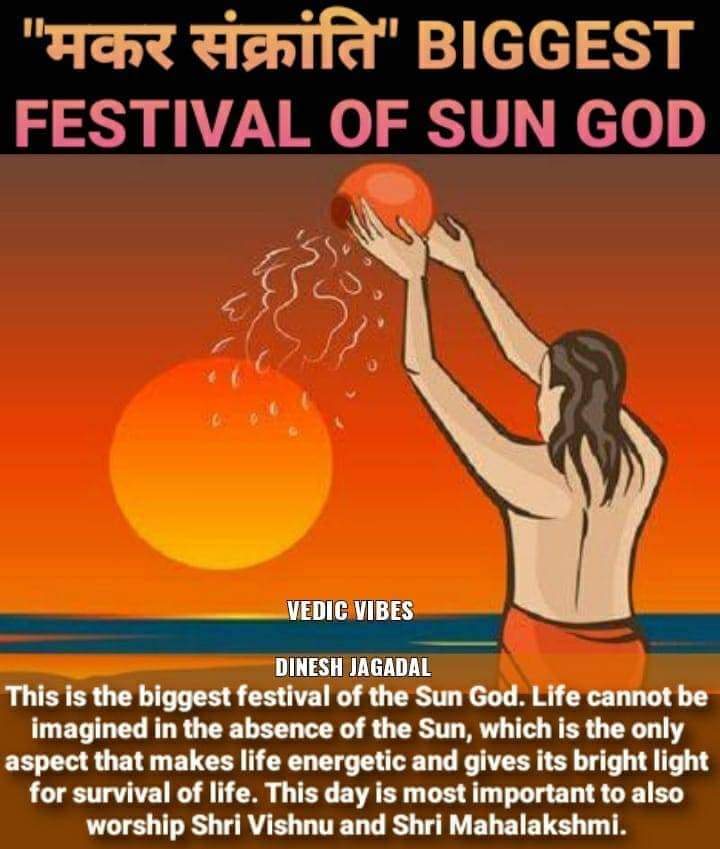

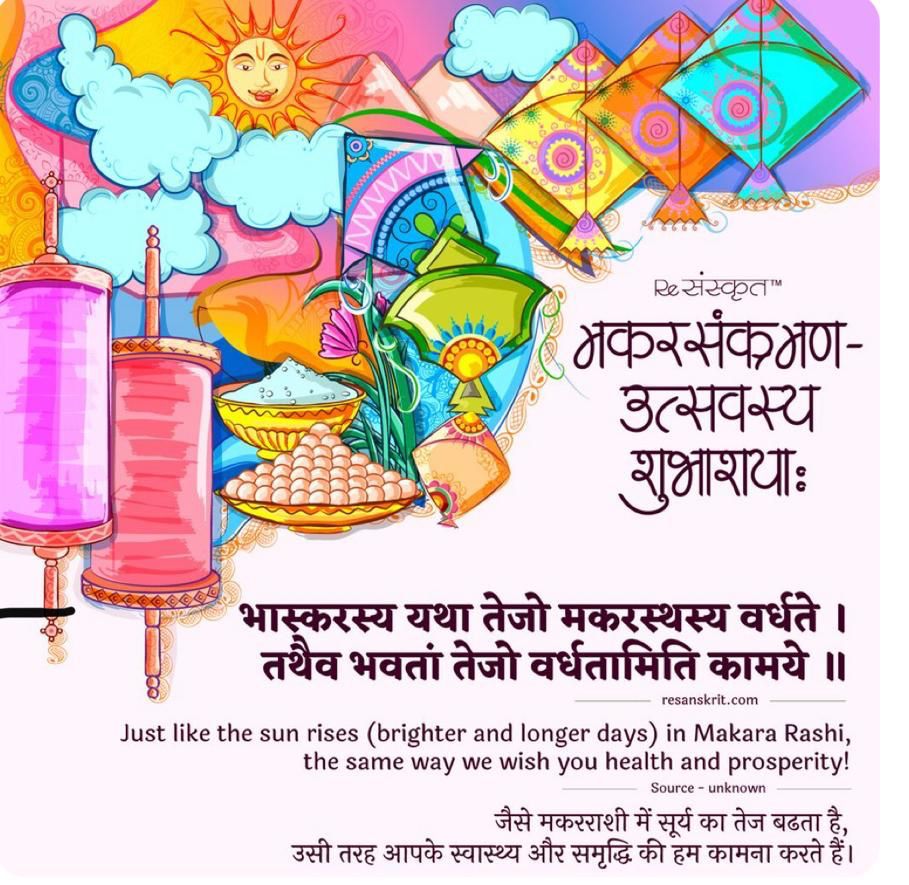
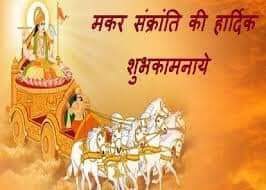
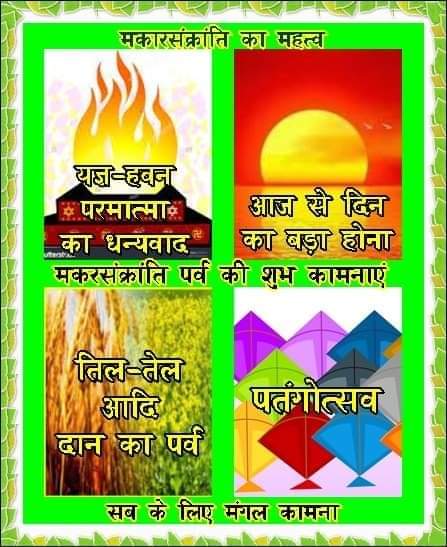
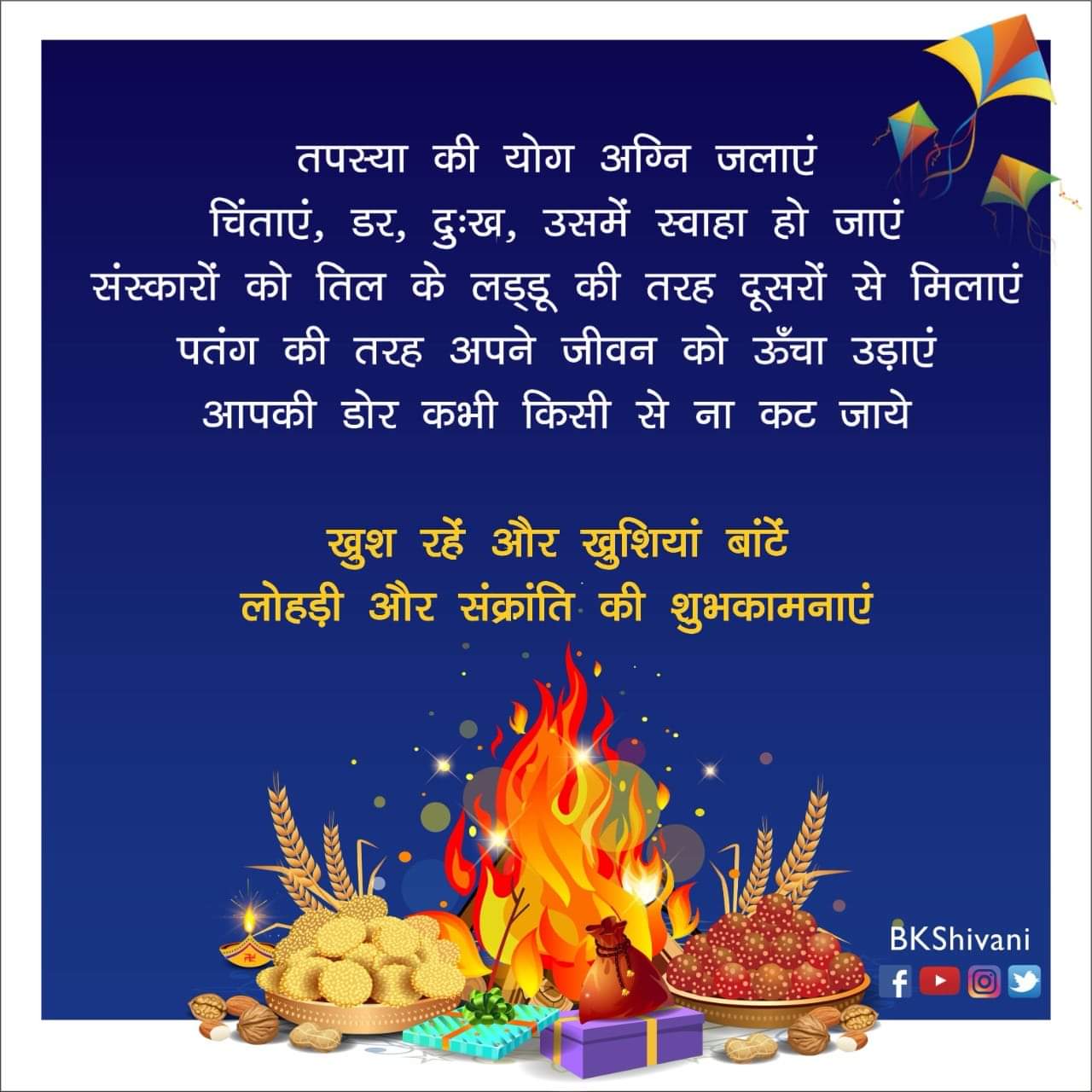
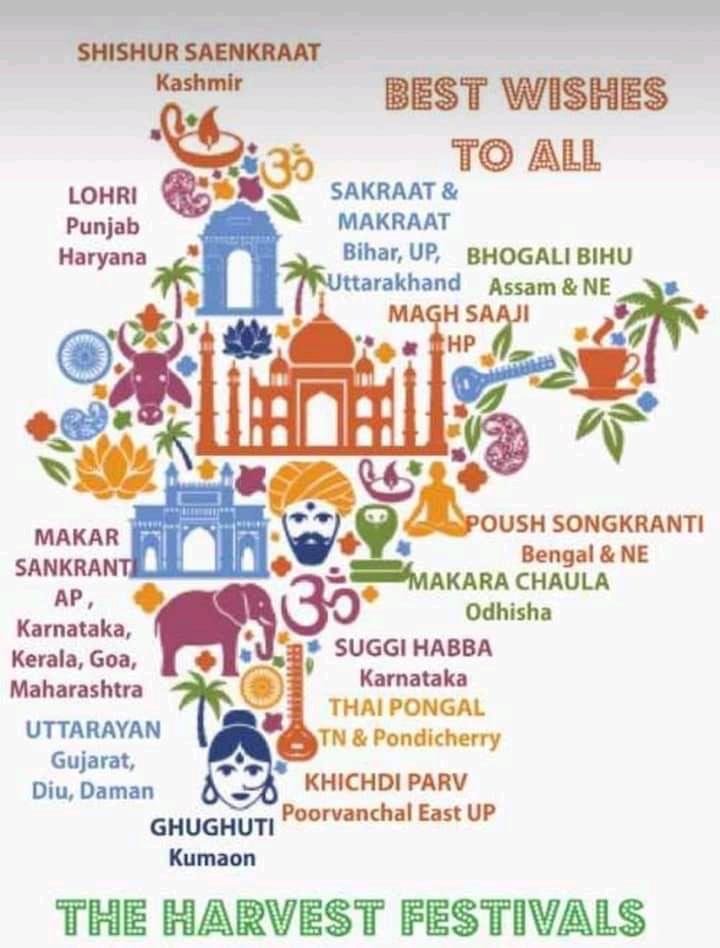
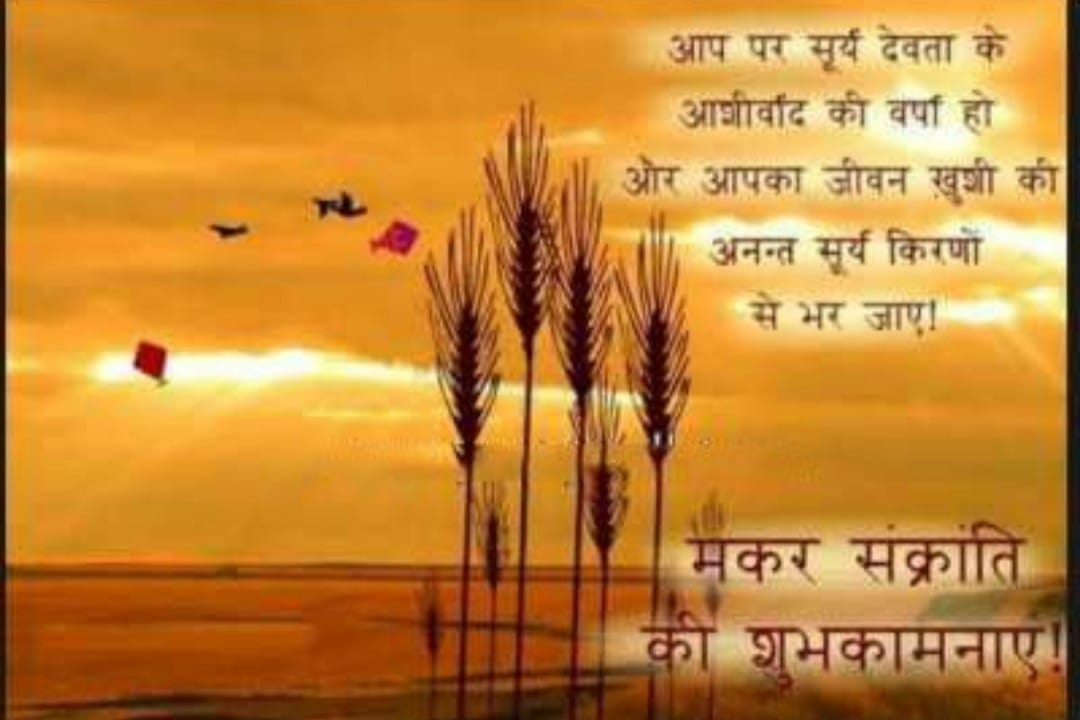
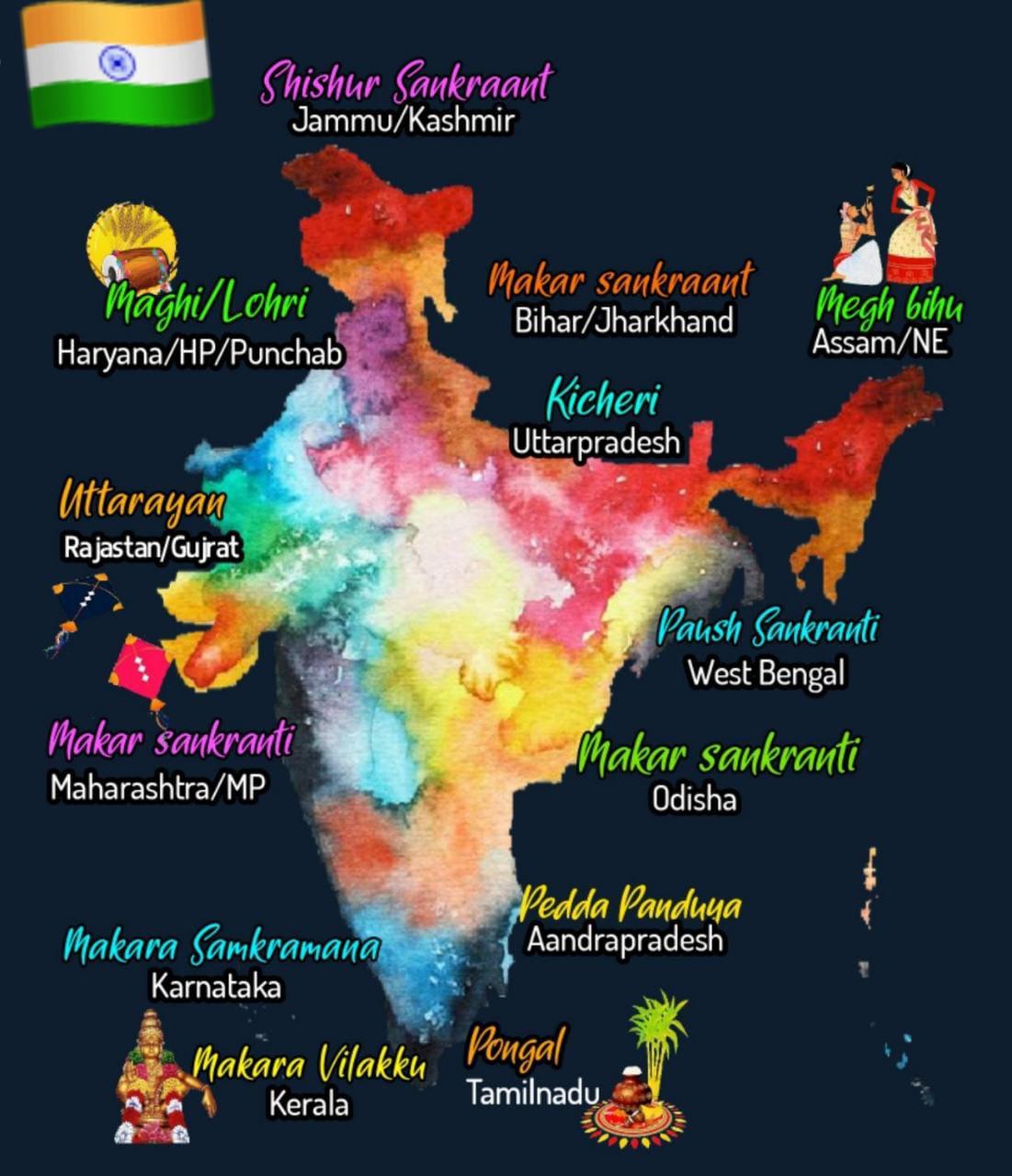
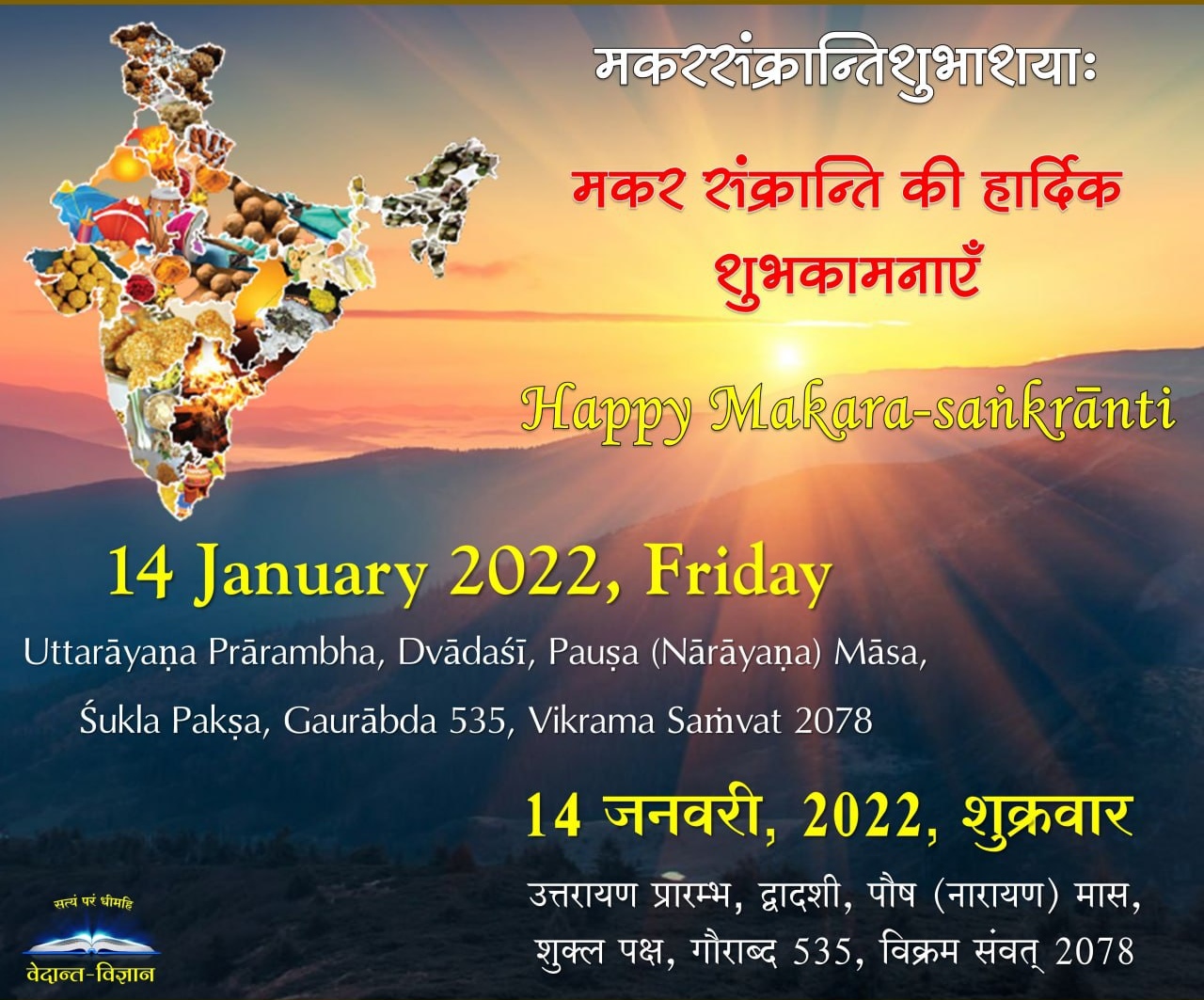
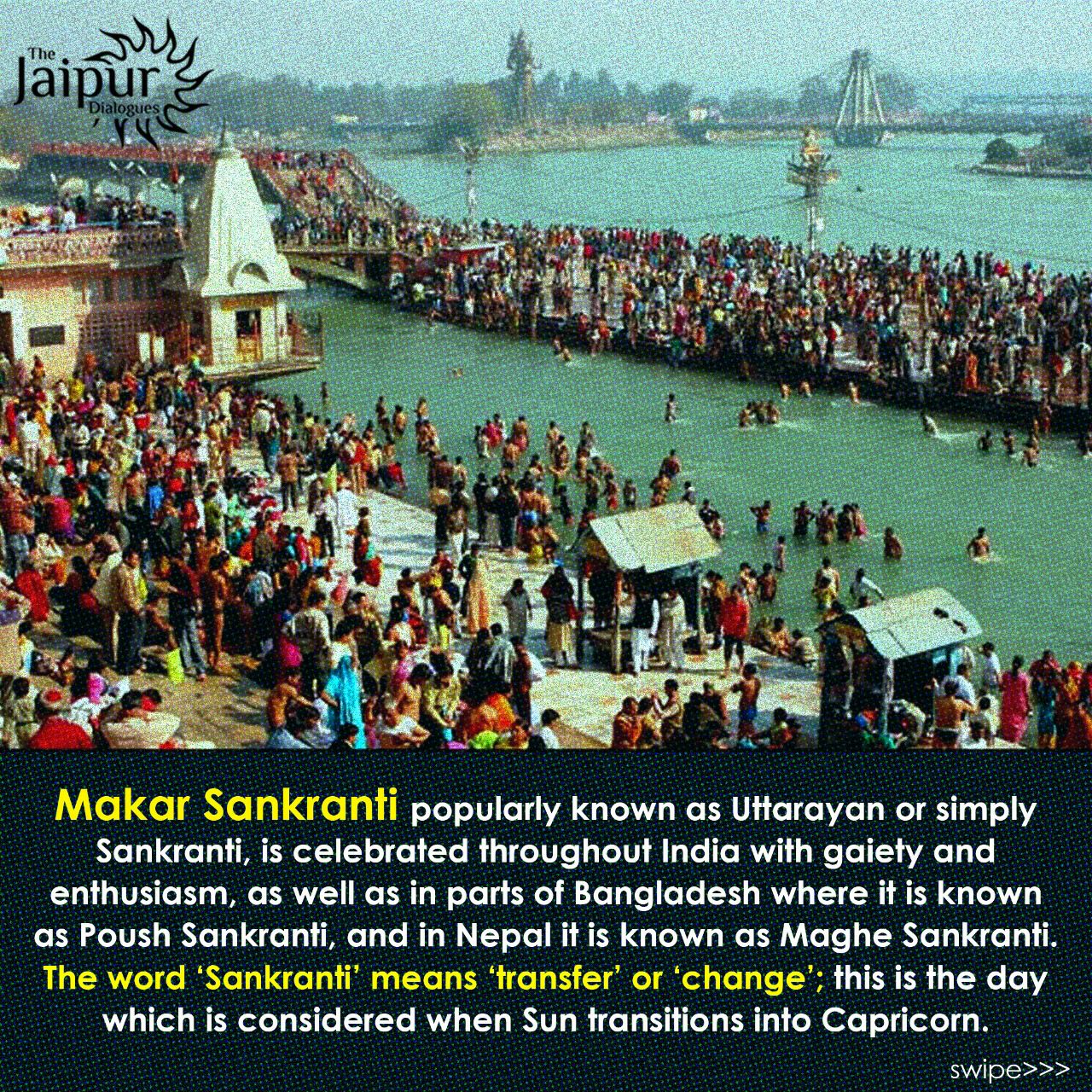
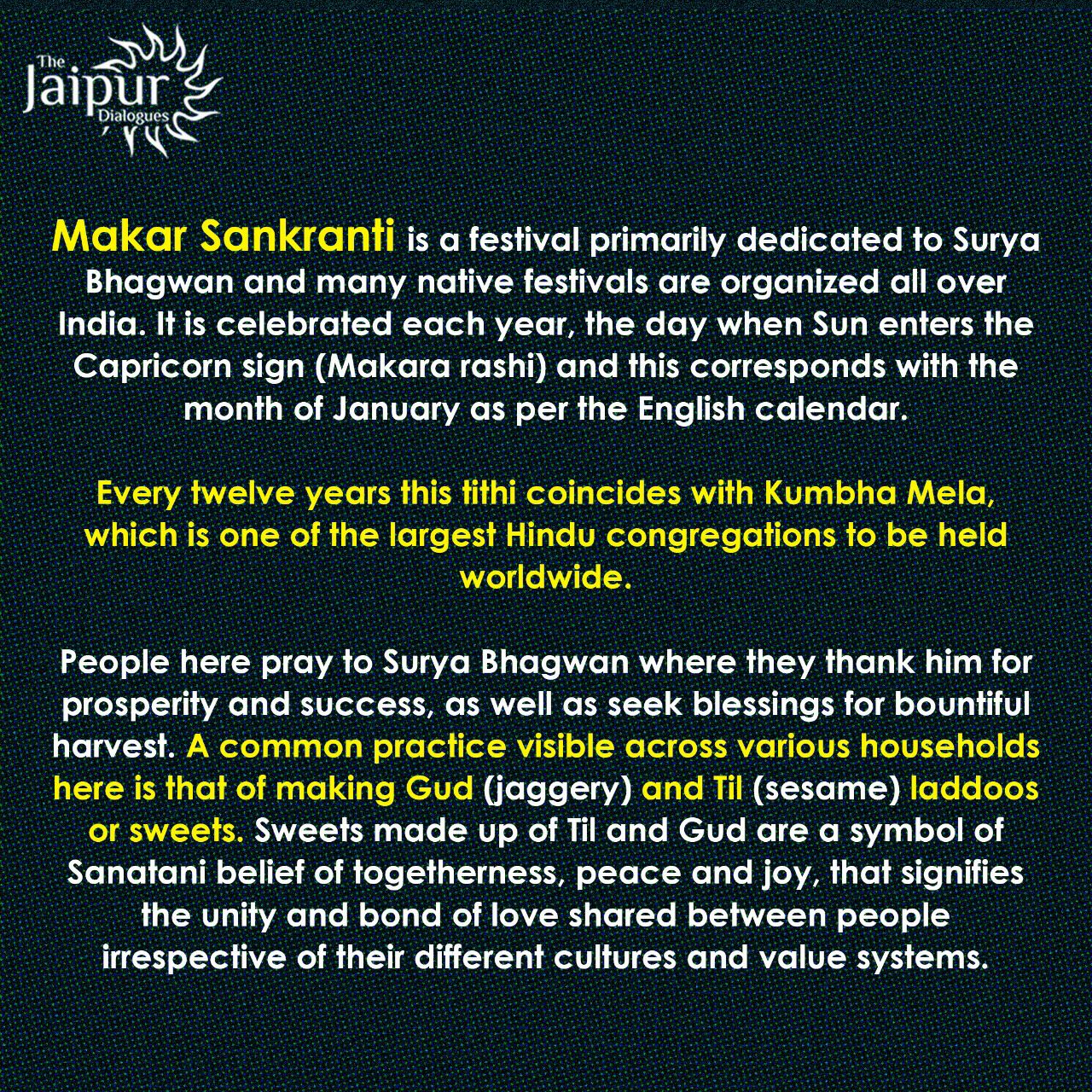
In different states of the nation, Makar Sankranti is celebrated by different names.
- Lohri: One day before Makar Sankranti, on thirteenth January, Lohri is celebrated in Haryana and Punjab. In the evening, people gather around the bonfire and throw puffed rice and popcorns into the flares of the huge fire. Prayers and wishes are made seeking for happiness, health, growth and prosperity.
- Kite Festival: In Gujarat, the kite celebration is held on the wonderful occasion of Makar Sankranti.
- Festival of Donation "or" Khichdi ": In Uttar Pradesh, it is chiefly the celebration of gift and donation. The Magh fair, which takes place for one month on the conjunction of Ganga, Yamuna and Saraswati in Allahabad, begins from the day of Makar Sankranti itself. On this propitious day, individuals fast in Uttar Pradesh and offer khichdi. Likewise, Khichdi Mela is held at Gorakhdham in Gorakhpur.
- In Bengal, there is a custom of donating til after taking a dip in the Makar Sankrant. Big fairs are additionally put up in Gangasagar every year.
- Pongal: On the colourful occasion of Makar Sankranti in Tamil Nadu, this celebration is praised as Pongal for four days.
- In Bihar, Makar Sankranti celebration is known as Khichdi. On this day, giving urad, rice, gold, woollen garments, have their own significance.
- In Maharashtra, all married ladies donate cotton, oil and salt to other suhagans (married woman) on their first Sankrant.
So, in India, Makar Sankranti celebration has its own significance. It is praised and celebrated in different states by various names.
Pongal/Makar Sankranti/Lohri:
This winter harvest festival is celebrated in mid-January by numerous communities. In TamilNadu, it is the year’s most important festival, celebrated over four days and dedicated tothe Sun God. The word pongal means brimming over, and milk is ritually allowed to boilover the rim of the pot to symbolise plenty. Pongal is also the name of sweet and salty ricebased dishes prepared for the occasion. Local festivities include painting and showcasing of livestock, feeding of birds and decoration of homes with sacred plants representing plenty, such as banana stalks and mango leaves.
Lohri, celebrated on January 13 in Punjab, and Makar Sankranti or Maghi, celebrated on January 14-15 in most other states of India, are other versions of the same festivities. The festival coincides with the northward movement of the sun, called Uttarayana, in which the sun enters the Capricorn sign of the Indic zodiac, and preempts the gradual heating of the earth until the summer solstice.
ॐ असतो मा सद्गमय।
तमसो मा ज्योतिर्गमय।
मृत्योर्मामृतं गमय ॥
ॐ शान्ति शान्ति शान्तिः ॥
- बृहदारण्यकोपनिषद् 1.3.28
हमारे हृदय के भीतर आत्मा का प्रकाश प्रकट हो, इस हेतु ईश्वर से प्रार्थना करते हैं।
इस प्रकाश पर्व मकर सक्रांति पर आप सबको सपरिवार हार्दिक शुभकामनाएं।
ओम तत्सत
Makar( crocodile) swallows the darkness on makar sankranti
-vitamin D is made by the body with sunlight.
-sesame seeds( til) have the highest calcium (975mg per 100g). Milk has 125mg only.
-the body is capable of storing vitamin D up to a year, and use the reserves.
-lastly, the body is capable of getting its viatmin D reserves full with 3 full days of sunlight.
-the best quality of sunlight is end of winter & beginning of summer.
Now join the dots, and see how wise our sages were of ancient India. They created a festival of flying kites where by our kids get excited to go in the open, under direct sunlight, throughout the day starting from early morning. And their mothers feed them homemade TIL laddoos.
Mattu Pongal – Bull Festival on the Third Day of Pongal
Pongal is a four day festival in Tamil Nadu and the third day is dedicated to Mattu (Ox, cow and other domesticated animals). Mattu Pongal 2022 date is January 15. Mattu Pongal is today famous in Tamil Nadu and in India for the bullfight known Jallikattu or Manji Virattu.
Mattu Pongal is a sort of thanksgiving to cattle, which provides milk, organic manure, and which draws the plough. The rural economy in India depends hugely on domesticated animals like ox, cow and goat.
Cattle are welcomed at home on the day and worshipped and are offered sweets and other eatables. Those homes having a cow or ox give them a thorough bath and are beautifully decorated with specially colored ropes, bells and shawls on the day. The horns are polished and painted. The cattle are taken to the temple. A Mangala arati is performed for the cattle.
But today sadly, Mattu Pongal is noted for the Jallikattu, a sort of wrestling match between man and bull, in rural Tamil Nadu. This is a cruel sport but is also a rural sport with history of more than 2000 years and therefore part of culture.

Kite festival:
Ministry of Culture is celebrating ‘Udaan’ a kite flying festival across the country on 14 January, 2022 as part of Azadi ka Amrit Mahotsav.
Udaan is intended to give wings to the ideas of freedom and independence through a kite-flying festival and many other cultural activities, in alignment with ‘Harvest Festivals’. More than 50+ events are being organised across states of Gujarat, Maharashtra, Bihar, Tamil Nadu, Madhya Pradesh, Delhi, Rajasthan, Punjab, Chhattisgarh, Jharkhand, Assam, Odisha, Haryana, Telangana, Uttar Pradesh and more covering multiple districts of the country.
Did you know that Kites were also a part of our freedom struggle?
साइमन कमीशन के विरोध में पतंगों पर "Simon Go Back" लिख कर ब्रिटिश सरकार का विरोध किया गया था। यह एक ऐसा प्रयोग था जिसका उपयोग इस कमीशन के विरुद्ध समाज में जागरूकता लाने के लिये किया गया।
Lala Lajpat Rai was hit on head by lathi which eventually led to his death in the Simon Go Back protest against the all white commission 😔. Bhagat Singh later took revenge by killing Saunders who had ordered to lathicharge.
Kites are also used to spread awareness messages and bring about social change.
पतंग उत्सव के मौके पर उड़ने वाली पतंगें आज समाज में जागरूकता लाने का भी काम कर रही हैं। इन पतंगों पर "बेटी बचाओ, बेटी पढ़ाओ" जैसे उद्देश्यों को सफल बनाने हेतु संदेश भी लिखे जाते हैं।
In his poetry, Namadeva alludes to kites that speak of the virtue of focus.
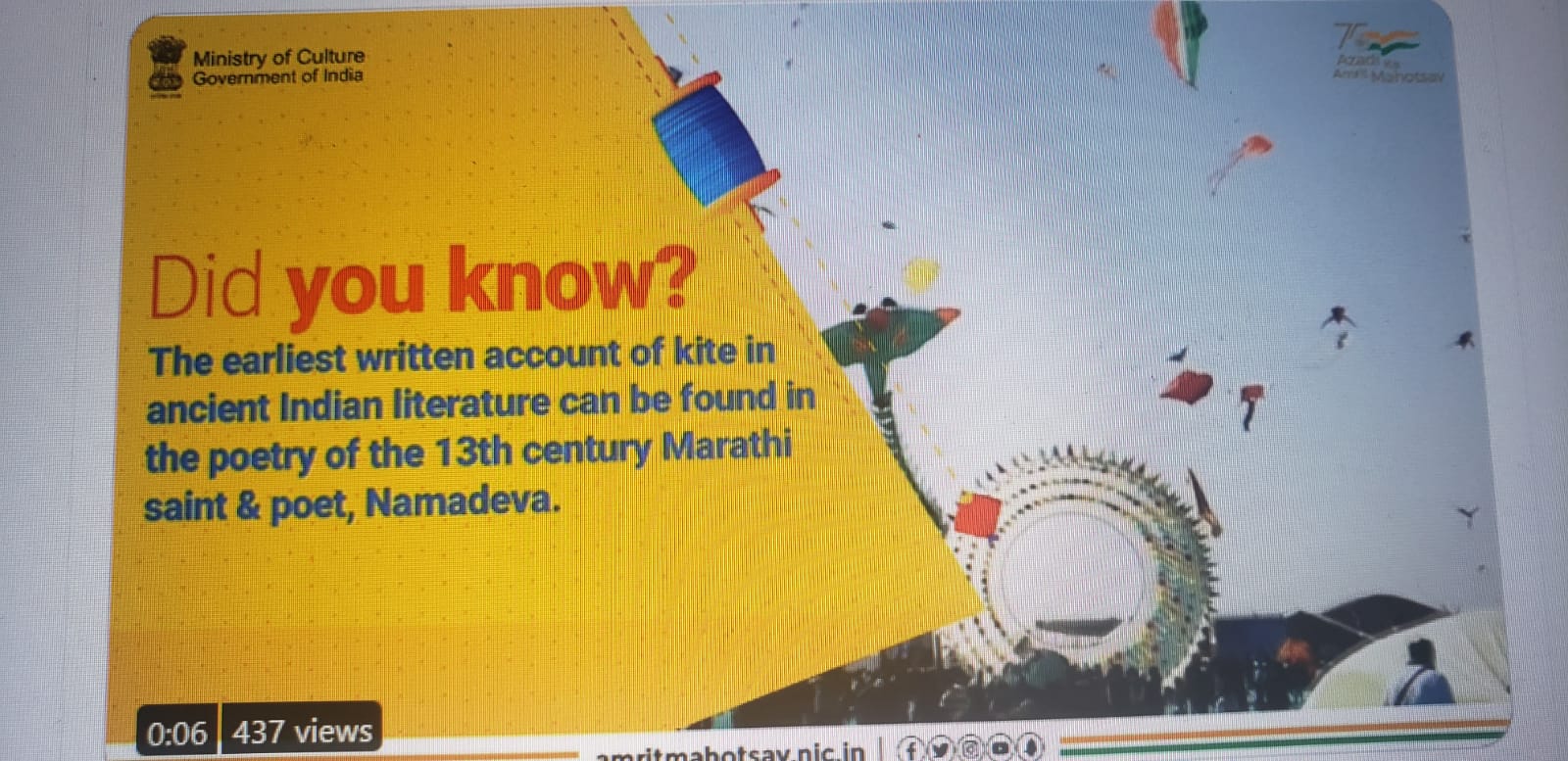
”A little boy is flying a kite in the sky. He is looking at the sky; he is talking to his friends ; he is moving up and down and discussing things here and there. But his attention is always focussed on the kite. Then, he says, a lady is carrying her little boy and doing her work in the house – giving water to her husband, sitting down with the kid, cooking and then rising up to do washing. The child is on her waist, resting. But her attention all the time is on the child. There is a woman holding a pitcher of water on her head delicately balanced. She is walking with other women. As they are walking together laughing, smiling, and talking to each other their attention is always on the pitcher of water, in the sense that the attention is on the atma.”
In the same way, though we have to lead a life here, it is absurd that we do not have our attention on our atma/innerself which is the giver of the ultimate in life.
The fun activity of kite-flying was favoured by the nobility, which gave rise to a culture of kite-craftsmanship and artistic kites slowly & steadily across the country.
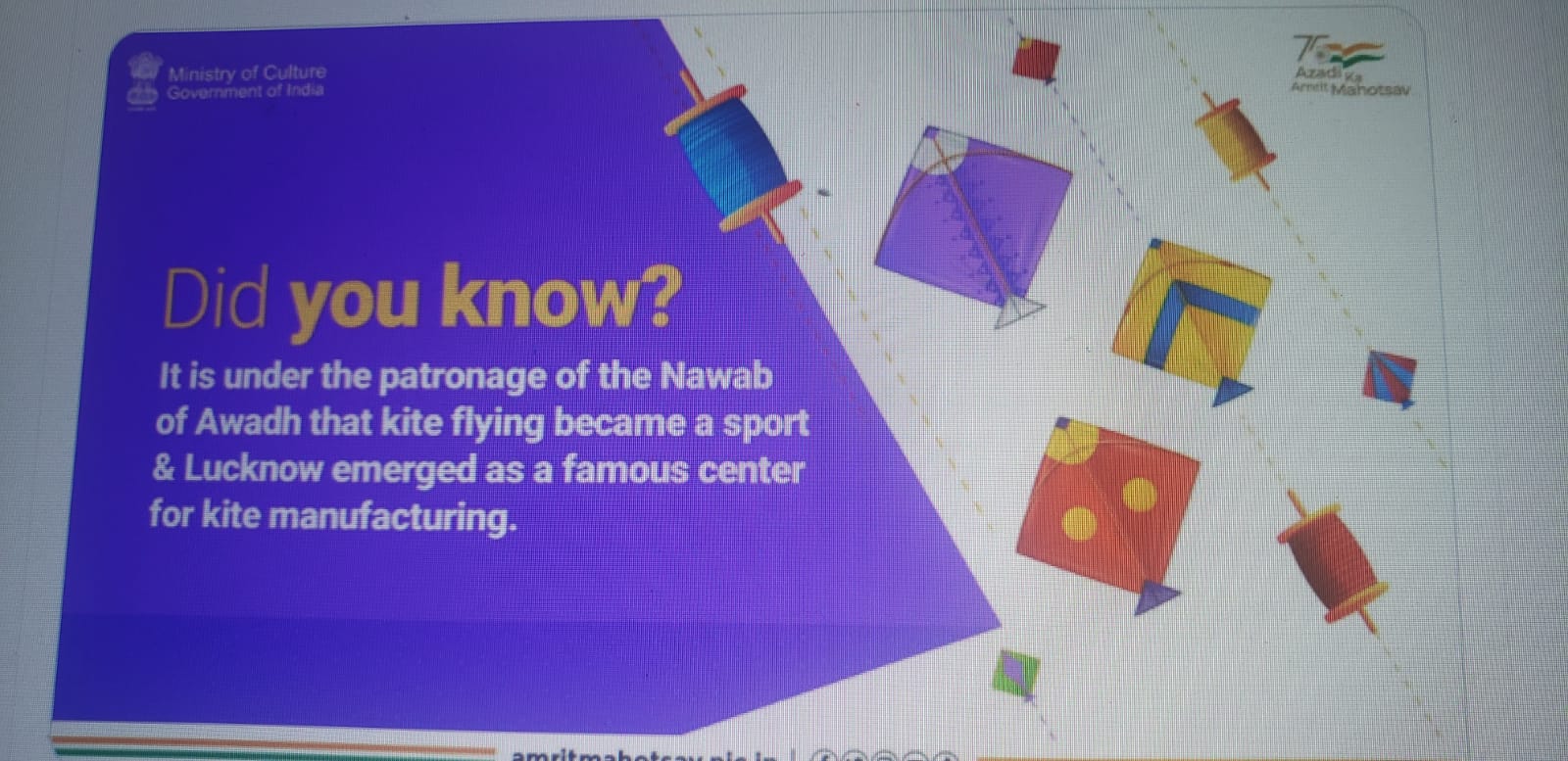
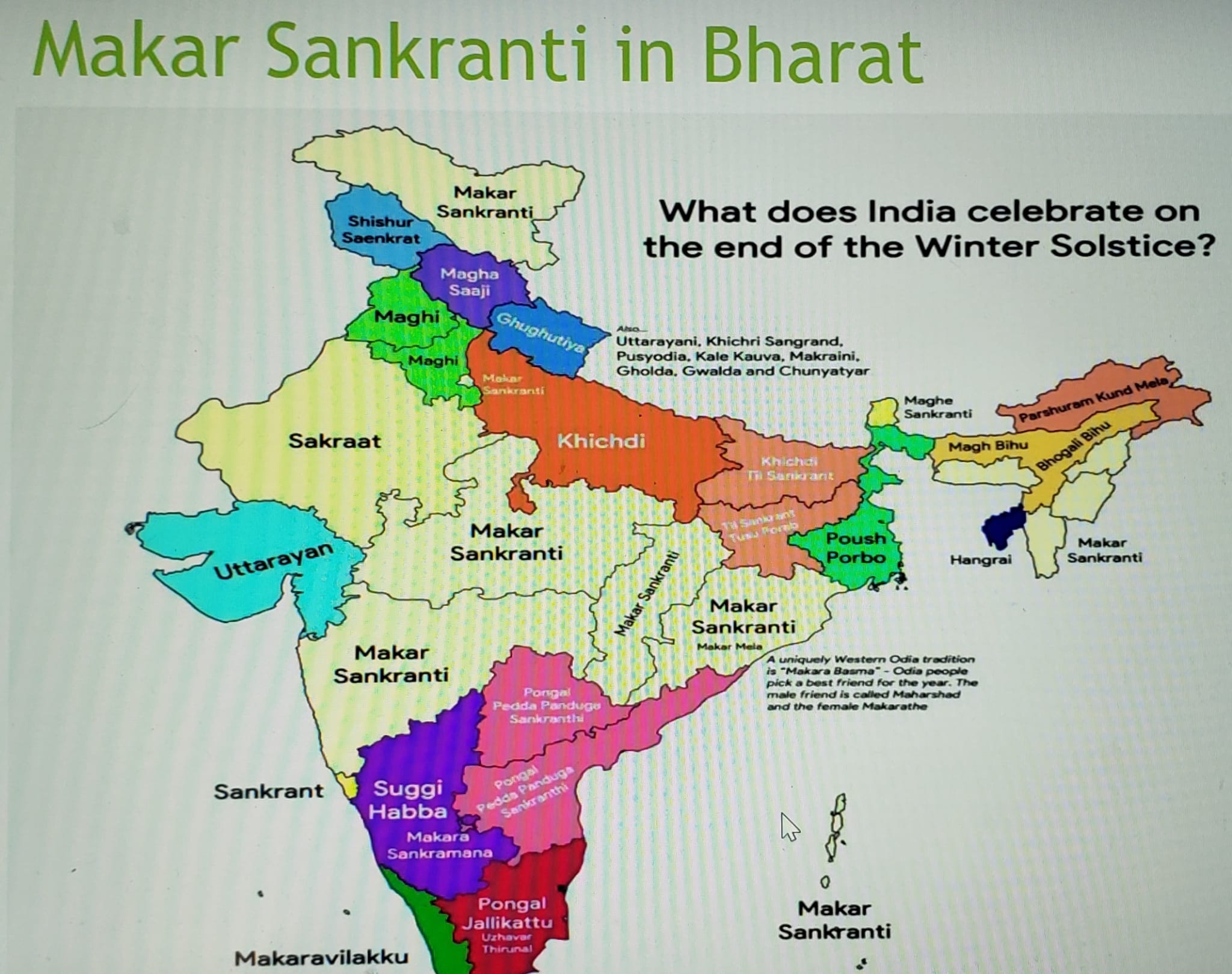
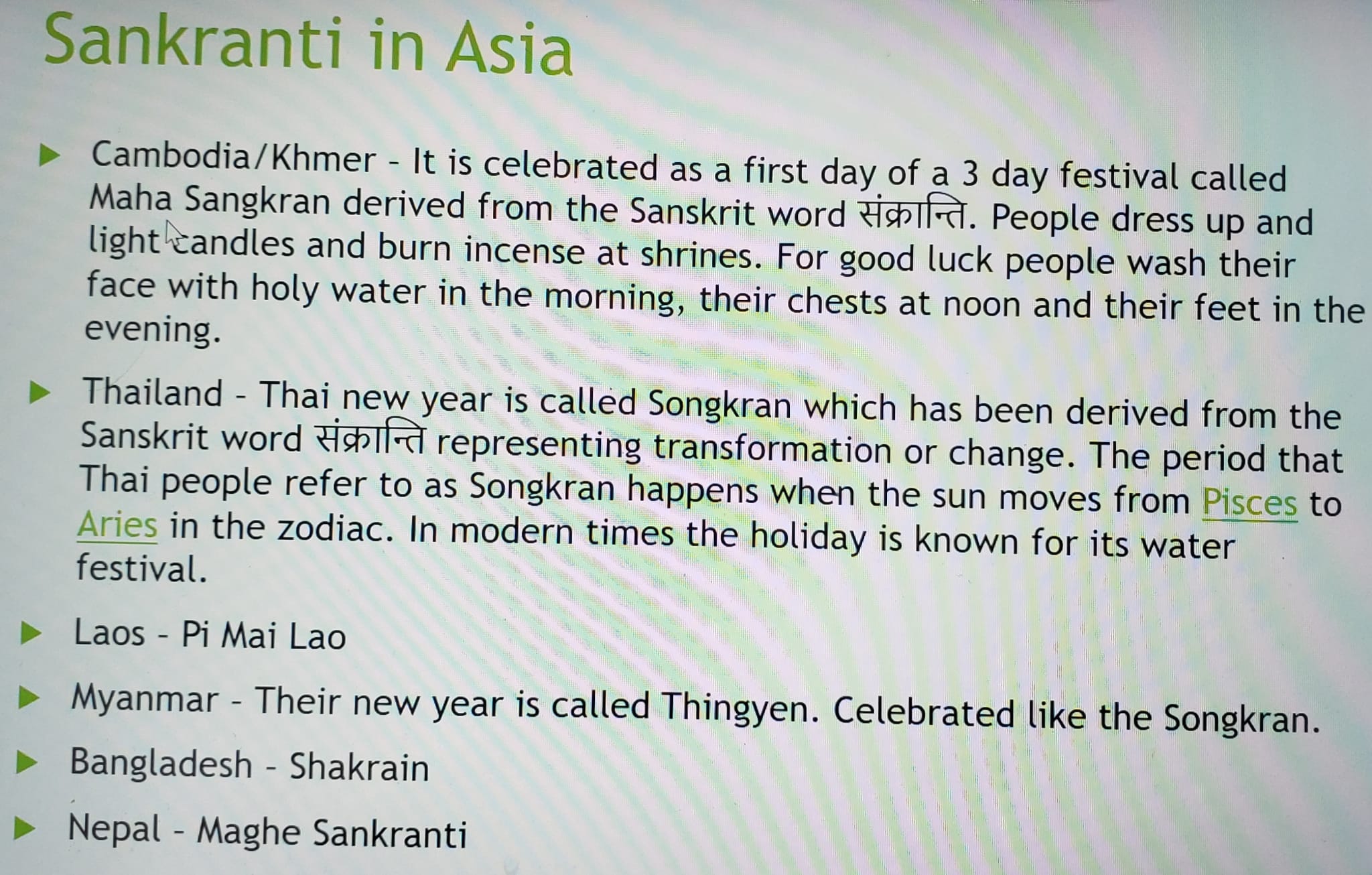
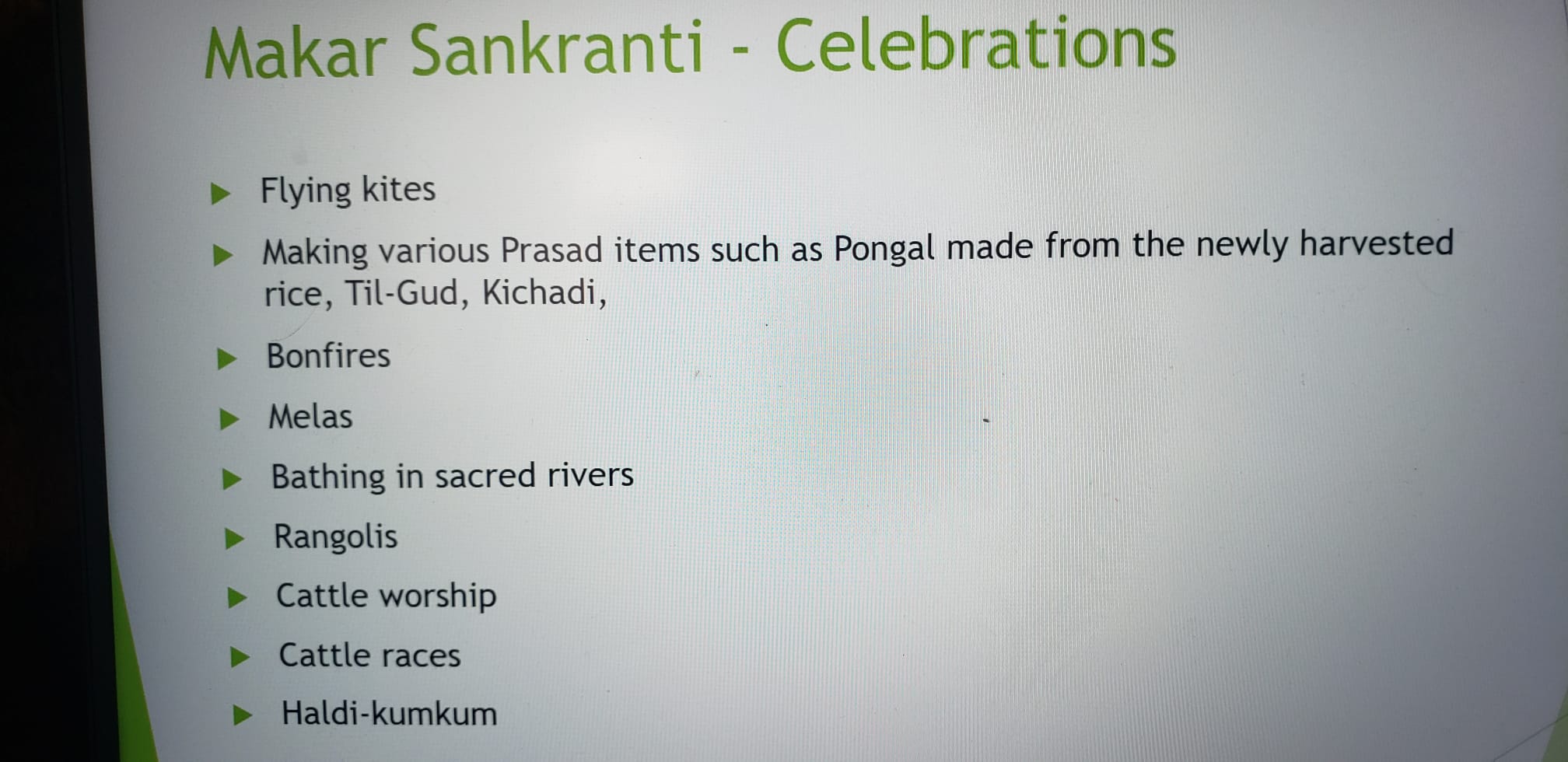
Winter solstice or Uttarayan is not same as Makar sankranti.
The winter solstice, also called the hibernal solstice, occurs when either of Earth's poles reaches its maximum tilt away from the Sun. This happens twice yearly, once in each hemisphere (Northern and Southern). For that hemisphere, the winter solstice is the day with the shortest period of daylight and longest night of the year, when the Sun is at its lowest daily maximum elevation in the sky.[3] Either pole experiences continuous darkness or twilight around its winter solstice. The opposite event is the summer solstice.
The winter solstice occurs during the hemisphere's winter. In the Northern Hemisphere, this is the December solstice (usually 21st or 22nd December) and in the Southern Hemisphere, this is the June solstice (usually 20th or 21st of June). Although the winter solstice itself lasts only a moment, the term also refers to the day on which it occurs.
विषय - मकर सङ्क्रान्ति उत्सव का मनाया जाना।
// उत्तरायण (मकर/ माघ) सङ्क्रान्ति- 'तमसो मा ज्योतिर्गमय' का महा पर्व //
उत्तर अयन इसी तिथि को है, सविता का सुप्रवेश हुआ ।
मान दिवस का इस ही कारण, अब से है सविशेष हुआ।।
वेद प्रदर्शित देवयान का जगती में विस्तार हुआ । उत्सव सङ्क्रान्ति मकर का जनता में सुप्रसार हुआ।।
तिल के मोदक, खिचड़ी, कम्बल, आज दान में देते हैं।
दीनों के दुःख दूर भगाकर, उनकी आशिष लेते हैं।।
- आर्य पर्व पद्धति से उद्घृत (लेखक - पण्डित भवानी प्रसाद) से।
तस्माद् दशगुण ज्ञेयं रवि सङ्क्रमणे बुधाः। विषुवेतद् दशगुणमयने तद्दशस्मृतम्।।
(अयनों और विषुव अर्थात सम्पातों को सङ्क्रान्तियों से जोड़ कर ही लिया गया है। इस एक खास बात का उक्त श्लोक प्रत्यक्ष और बलवन्त प्रमाण है।)
-
शिव महापुराण -विद्येश्वर संहिता -अध्याय १५ -श्लोक-५
आगामी तपस (माघ) मास, १ गते को प्रातः चर्यायें पूरी करके विधि पूर्वक सङ्कल्पोच्चार पूर्वक यज्ञ करें। सूर्य के मन्त्रों से विशेष आहुतियाँ सम्पन्न करें।
सूर्य सन्दर्भ के ऐसे कुछ विशेष मन्त्र मैं यहां दे रहा हूँ। आज के दिन गुड़ तिल का यज्ञ व प्रसाद बाँटने और देशी घी युक्त खिचड़ी के भोग की अच्छी परम्परा है। कुछ मित्रों ने सूर्य सन्दर्भित विशेष मन्त्रों को जानने का अनुरोध किया है। उन सभी का बहुत बहुत धन्यवाद।
विधि विनियोग पूर्वक गायत्री मन्त्र से आहुतियाँ करें। आर्य समाज में विधि विनियोग पूर्वक मन्त्र जप (आहुतियों) का प्रचलन नहीं के बराबर है; होना चाहिए। इच्छुक जनों के लिए कुछ मन्त्रों के बाद इस सन्दर्भ की कुछ जानकारी दे रहा हूँ। आशा है सभी धर्म प्रेमी जन मेरे सन्देश प्रयास पर प्रसन्नता का अनुभव करेंगे।
१. सप्त त्वा हरितो रथे वहन्ति देव सूर्य ।शोचिष्केशं विचक्षण ।।
( सन्दर्भ -ऋग्वेद मण्डल १। सूक्त ५०। मन्त्र ८ )
२. उद्यन्नद्य मित्रमह आरोहन्नुत्तराम् दिवम् ।हृद्रोगं मम सूर्य हरिमाणं च नाशय ।।
( सन्दर्भ -ऋ ० मण्डल १। सूक्त ५०। मन्त्र ११ )
३. यत्त्वा सूर्य्य स्वर्भानुस्तमसाविध्यदासुरः ।अक्षेत्रविद्यथा मुग्धो भुवनान्यदीधयु: ।। ( सन्दर्भ - ऋग्वेद मण्डल ५। सूक्त ४०। मन्त्र ५ )
४. स्वर्भानोरध यदिन्द्र माया अवो दिवो वर्त्तमाना अवाहन् ।गूलहं सूर्य्यं तमसापव्रतेन तुरीयेण ब्रह्मणाविन्ददत्रि: ।।
( सन्दर्भ -ऋग्वेद मण्डल ५। सूक्त ४०। मन्त्र ६ )
५. मा मामिमं तव सन्तमत्र इरस्या द्रुग्धो भियसा नि गारीत् ।त्वं मित्रो असि सत्यराधास्तौ मेहावतं वरुणश्च राजा ।।( सन्दर्भ -ऋग्वेद मण्डल ५। सूक्त ४०।मन्त्र ७ )
६. ग्राव्णो ब्रह्मा युयुजानः सपर्य्यन् कीरिणा देवान्नमसोपशिक्षन् ।अत्रि: सूर्य्यस्य दिवि चक्षुराधात्स्वर्भानोरप माया अघुक्षत् ।। ( सन्दर्भ -ऋग्वेद मण्डल ५। सूक्त ४०।मन्त्र ८)
७. यं वै सूर्यं स्वर्भानुस्तमसाविध्यदासुरः ।अत्रयस्तमन्वविन्दन्नह्यऽन्ये अशक्नुवन् ।। ( सन्दर्भ -ऋग्वेद मण्डल ५। सूक्त ४०। मन्त्र ९। )
८. शीर्ष्णः शीर्ष्णो जगतस्तस्थुषस्पतिं समया विश्वमा रजः ।सप्त स्वसारः सुविताय सूर्यं वहंति (वहन्ति) हरितो रथे ।।
( सन्दर्भ -ऋग्वेद मण्डल ७। सूक्त ६६। मन्त्र १५। )
९. तच्चक्षुर्देवहितं शुक्रमुच्चरत् ।पश्येम शरदः शतं जीवेम शरदः शतम् ।।
(ऋग्वेद सूक्त ७। मण्डल ६६। मन्त्र १६। - यहाँ चक्षु: का अर्थ सूर्य है।) ,
१० . वण्महाँ असि सूर्यं वलादित्य महाँ असि ।महस्ते सतो महिमा पनस्यतेऽद्धा देव महाँ असि ।।
(सन्दर्भ -ऋग्वेद मण्डल ८। सूक्त १०१। मन्त्र ११। )
११ . वट् सूर्यं श्रवसा महाँ असि सत्रा देव महाँ असि ।मह्ना देवानामसुर्यः पुरोहितो विभु ज्योतिरदाभ्यम् ।।
(सन्दर्भ -ऋग्वेद मण्डल ८। सूक्त १०१। मन्त्र १२। )
१२ . सविता पश्चातात्सविता पुरस्तात्सवितोत्तरात्तात्सविताधरात्तात् ।सविता नः सुवतु सर्वतातिं सविता नो रासता दीर्घमायु: ।।
(सन्दर्भ -ऋग्वेद मण्डल १०। सूक्त ३६। मन्त्र १४। )
१३ . चित्रं देवानामुदगादनीकं चक्षुर्मित्रस्य वरुणस्याग्ने: ।आप्रा द्यावापृथिवी अन्तरिक्षं सूर्य आत्मा जगतस्तस्थुषश्च ।।
(सन्दर्भ -ऋग्वेद मण्डल १। सूक्त ११५ । मन्त्र १ । )
१४ . तन् मित्रस्य वरुणस्याभिचक्षे सूर्य्यो रूपं कृणुते द्योरुपस्थे ।अनन्तमन्यद्रुशदस्य पाजः कृष्णमन्यद्धरितः संभरन्ति ।।
(सन्दर्भ -ऋग्वेद मण्डल १। सूक्त ११५। मन्त्र ५ । )
१५ . आ कृष्णेन रजसा वर्त्तमानो निवेशयन्नमृतं मर्त्यं च । हिरण्ययेन सविता रथेना देवो याति भुवनानि पश्यन् ।।(सन्दर्भ -ऋग्वेद मण्डल १। सूक्त ३५ । मन्त्र २। )
१६ . याति देवः प्रवता यात्युद्वता याति शुभ्राभ्याम् यजतो हरिभ्याम् ।आ देवो याति सविता परावतोऽप विश्वा दुरिता बाधमानः ।।
(सन्दर्भ -ऋग्वेद मण्डल १। सूक्त ३५ । मन्त्र ३।)
१७ . तिस्रो द्यावः सवितुर्द्वा उपस्थाम् एका यमस्य भुवने विराषाट् ।आणि न रथ्यममृताधितस्थुरिह ब्रवीतु य उ तच्चिकेतत्।(सन्दर्भ - ऋग्वेद मण्डल १ सूक्त ३५ । मन्त्र ६।)
१८ . वि सुपर्णो अन्तरिक्षाण्यख्यद् गभीरवेपा असुरः सुनीथः । क्वे३दानीम् सूर्यः कश्चिकेत कतमां द्यां रश्मिरस्या ततान।(सन्दर्भ -ऋग्वेद मण्डल १ सूक्त ३५ । मन्त्र ७ ।)
१९. . अष्टौ व्यख्यत्ककुभः पृथिव्यास्त्री धन्व योजना सप्त सिन्धून् ।हिरण्याक्षः सविता देव आगाद्दधद्रत्ना दाशुषे वार्याणि ।।
(सन्दर्भ -ऋग्वेद मण्डल १ सूक्त ३५ । मन्त्र ८ ।)
२० . हिरण्यपाणि: सविता विचर्षणिरुभे द्यावापृथिवी अन्तरीयते ।अपामीवाम् बाधते वेति सूर्यमाभिकृष्णेन रजसा द्यामृणोति ।।
(सन्दर्भ - ऋग्वेद मण्डल १। सूक्त ३५ । मन्त्र ९ ।)
सूर्य से सम्बन्धित और उपर्क्तयु २० मन्त्र अति विशिष्ठ हैं। ऋग्वेद के मण्डल १। सूक्त ४९ से लिए गए ये हैं। इनका देवता सूर्य ही है। ये सारा सूक्त सङ्क्रान्तियों से जुड़े पार्विक यज्ञों में उपयोगी हैं।
इन मन्त्रों के बाद गायत्री मन्त्र ( ऋषि विश्वामित्र एवं देवता सविता ) और पुनः महामृत्युञ्जय मन्त्र ( ऋषि वशिष्ठ और त्र्यम्बक रुद्रोदेवता) का विधि विनियोग पूर्वक ५,१०, १५ या २० -२० ( जैसे भी आपके पास समय हो) आहुतियाँ देकर यज्ञ पूर्ण करें।
विनियोग - सीधे हाथ की हथेली में जल-चावल लेकर पुनः बायीं हथेली पर सीधी हथेली रखकर श्रद्धा पूर्वक विनियोग पाठ ( विनियोग पढ़ना ) करें। जिन लोगों को विनियोग पाठ नहीं करना हो वे नहीं करें।
विनियोग पाठ आपकी जानकारी के लिए यहां दिए जा रहे हैं-
1 गायत्री मन्त्र का विनियोग -
गायत्री मन्त्र पढ़कर पुनः। ....... ओ३म् अस्य गायत्री मन्त्रस्य विश्वामित्र ऋषि सविता देवता निचृद् गायत्री छन्दः षड़जः स्वरः आधि-व्याधि प्रशमन पूर्वक दीर्घ आयु विपुल बल पुष्टि नैरुज्यादि सकल अभीष्ट सिध्यर्थं सविता देवता प्रसाद सिध्यर्थं च गायत्री मन्त्र जपे विनियोगः।
इसके साथ ही जल को अपने सम्मुख आसन के सामने ही छोड़ दिया जाता है।अगर किसी को और अधिक मार्ग दर्शन की आवश्यकता हो तो वह भाई बहिन मुझसे विनियोग पाठ के ऑडियो की माँग कर सकते हैं।
२. महामृत्युञ्जय मन्त्र का विनियोग -
महा मृत्युञ्जय मन्त्र पढ़कर पुनः ..... ओ३म् अस्य महा मृत्युञ्जय मन्त्रस्य वशिष्ठ ऋषिः त्र्यम्बक रुद्रो देवता अनुस्टुप् छन्दः षड़जः स्वरः आधि-व्याधि प्रशमन पूर्वक दीर्घ आयु विपुल बल पुष्टि नैरुज्यादि सकल अभीष्ट सिध्यर्थं च महा मृत्युञ्जय देवता प्रसाद सिध्यर्थं महा मृत्युञ्जय मन्त्र जपे विनियोगः।
इसके साथ ही जल को अपने सम्मुख आसन के सामने ही छोड़ दिया जाता है।
उस दिन के लिए (विनियोग की तरह हथेली में जल एवं अक्षत लेकर) सङ्कल्प पाठ इस प्रकार से होगा -
ओ३म् तत्सत् श्री ब्रह्मणो द्वितीये परार्द्धे श्री श्वेत वाराह कल्पे वैवस्वतमन्वन्तरे अष्टाविंशतितमे कलियुगे कले: प्रथमचरणे एकवृन्द -सप्तनवतिकोट्येकोनत्रिंशल्लक्षैकोनपञ्चाशत्सहस्त्रयुत द्वाविंशत्यधिक शततमे ( १९७२९४९१२२ ) सृष्ट्यब्दे सप्त सप्तत्युत्तर द्विसहस्रतमे (२०७७ ) वैक्रमाब्दे, आनन्द संवत्सरे उत्तरायणे शिशिर ऋतौ मासानां मासोत्तमे तपस् मासान्तर्गते पौष कृष्ण तृतीयायां तिथौ पुनर्वसु नक्षत्रे मकर (अथवा कुम्म) लग्नोदये...... मुहुर्ते ब्रह्म मनु वशिष्ठ विश्वामित्र भरद्वाज कपिल कणाद पाणिनि पतञ्जलि गोतम व्यास जैमिनी शङ्कराचार्य दयानन्द सरस्वती महर्षिभिस्सेविते भूर्लोके जम्बूद्वीपे भारतवर्षे भरतखण्डे आर्यावर्तान्तर्गते ........ (प्रान्त का नाम ) प्रदेशैक देशान्तर्गते अत्र .......( जिले का नाम) नामकस्य जनपदस्य ( ........ग्राम या स्थान का नाम ) ग्रामे /स्थाने ........ (अपने गोत्र का नाम) गोत्रज/गोत्रजा पूज्यपाद स्वर्गीय श्री ----(अपने किसी पूर्वज का नाम)............महाभाग तस्य वंशधरोऽहं / वंशधराऽहं..... ( अपना नाम ) - - - - - - - - - अस्मिन् उत्तरायण सङ्क्रान्ति वेलायां आत्मकल्याणार्थं पर्यावरणप्रदूषणं अपाकर्तुं च यज्ञमिमं करिष्ये।(हथेली का जल छोड़ दीजिये और पुनः ह विनती भाव पूर्वक) -
तेन तृप्यतु यज्ञदेवस्तस्मै देवाय नमो नम: (नमस्कार मुद्रा के साथ) कहें।
स्वस्ति ओं शम्।
Reinventing the Indian (Hindu) Calendar
by Dr. Rajen Barua
Summary:
Following the Indian (Hindu) calendar, we Indians are celebrating the seasonal festivals on wrong dates. It is because in the Indian calendars, the seasons are out of phase with the real tropical phenomenon of the earth. This article analyses how and why we are doing that and what to do about it.
In the Indian calendars, the Makar Sankranti which marks the transition of the Sun into Makar Rasi (Capricorn), generally falls around 14th or 15th January of the Gregorian calendar. Makar Sankranti also is said to mark many of the Indian harvest festivals such as the Pongal of the Tamils, the Bhogali Bihu of the Assamese, the Maghi (Lohri) of the Punabis, Bhogi in Andhra Pradesh etc. Many communities start their new years on this date. Astronomically, Makar Sankranti is the winter solstice. It is the shortest day marking the beginning of the Uttarayan (the northern journey) of the Sun with gradual increase of the duration of the day. The Bhagavad Gita mentions great importance of the Uttarayan. This was the reason why Bhishma, when wounded in Mahabharata war, chose to await for the Makar Sankranti, before choosing to die. In the Jagannath temple at Puri the Uttarayana Yatra is celebrated on this Makar Sankranti day. If one goes to the Internet and search, this is what one gets for Makara Sankranti: “Makara Sankranti is a Hindu festival celebrated in almost all parts of India. Makara Sankranti marks the transition of the Sun into the zodiac sign of Makara rashi (Capricorn) on its celestial path. The day is also believed to mark the arrival of spring in India and is a traditional. Makara Sankranti is a solar event making one of the few Indian festivals which fall on the same date in the Gregorian calendarevery year: 14 January.”
Like the Makar Sankranti, three other sankrantis mark the cardinal poles of equinoxes and solstices of the Indian calendar. The Mesha Sankranti marks the spring equinox, the Karkat sankranti marks the summer solstice and the Tula sankranti marks the autumnal equinox. Like the solstice, an equinox (equi=equal, nox=night) occurs twice a year. According to the Indian calendar, the spring equinox (Mesha Sankranti) falls around April 14th-15th when the Assamese celebrates the Rongali Bihu, their springtime festival, when they also usher in their New Year. Like the Assamese, the Bengalis celebrate Baishagi and the people of Kerala also celebrate Vishu on this Mesha Sankranti day as their new year.
However, there is a fallacy in all these celebrations because if we follow the Indian calendar, you will notice that the dates of these festivals do not fall either on correct dates of the seasons nor these fall on correct dates of the equinoxes and solstices. To make the point clear, let us take the case of Makar Sakranti which is celebrated around January 14th at present time. However, as we all know, the winter solstice falls not on January 14th but it actually falls on Dec 21st which is the shortest day of the year and also denotes the end of winter and marks the official start of the harvest season. Thus to be correct with the seasons and with the solstices, the Makar Sankranti should fall on 21st Dec and not on 14th Jan. It is apparent that something is wrong with the Indian (Hindu) calendar. As a matter of fact, in the Indian calendar system, the tropical seasons (and the solstices and the equinoxes along with it) are out of phase by 24 days with the correct seasonal phenomenon as marked by the Gregorian calendar. To make matters worse, it is not only out of phase, but that this out of phase is also increasing every year.
We will try to analyze how and why the Indian calendar is out of phase with the seasons and what to do about it. First, the reason why it is out of phase is very simple. We are measuring the solar year by a different method than being measured by the Gregorian calendar. Basically, we are measuring what is called a ‘sidereal’ (Sans. sayana) solar year while the scientific community is measuring a ‘tropical’ (Sans. nirayana) solar year. This brings us to the question how differently we measure a solar year.
The solar year is measured by counting the time period of the successive return of the earth to the same reference point on the ecliptic. However, we can measure it two ways. We may take one reference point by taking a fixed background star on the ecliptic. In this system, the solar year measured, is the actual time taken for the earth to revolve once around the Sun with respect to a fixed star. This is known as the sidereal year. However, another reference point may be taken as the ‘equinox point’. That is, you measure the time from (say) one spring equinox to the next spring equinox. The year you measure thus is known as the tropical year.
Tropically, the harvest season starts when the winter ends on the Winter Solstice which is, as we all know, on 21st Dec. Thus to be correct with the season and with the solstice, the Makar Sankranti should fall on 31st Dec and not on 14th Jan. Thus the Hindu calendar system, the tropical seasons are out of phase by about 24 days with the actual seasonal phenomenon and with the actual tropical calendar of as practiced by the world that follows the Gregorian calendar. So are the solstices and the equinoxes along with it.
Let us now see how the discrepancy of 24 days has crept into the present Indian calendars. According to Surya Siddhanta, an ancient astronomical treaties, the Indian sidereal (sayana) year apparently coincided with the tropical (nirayana) year in KY (Kali Yugo) 3600, which has now been standardized as the as 285 AD. It means that in 285 AD, the solstices and the equinoxes were per the present Gregorian calendar; Makar Sankranti fell on 21st Dec and the Mesha Sankranti on 21st March etc. Since then however the equinoxes are precessing in the Hindu calendar at the rate of 20 minutes a year for total (2013-285)=1728 years, and this accounts for the (1728*20)/60/24 = 24 days discrepancy that we have today. To bring the matter home, we may note that at the present rate, we find that 500 years ago, the Hindus were celebrating the Makar sankranti around 7th January and that in another 500 years from now, we will be celebrating it on 21st January instead of the 14th January as we do today.
It is not that we Indians did not try to reform the calendar in modern times. The Indian Calendar Reform Committee tried to reform the Hindu calendar, and a unified calendar was introduced in 1957 creating a National tropical calendar which also tried to incorporate the Hindu religious calendars. This effort however failed mainly due to the orthodox schools of Vedic astrology which simply rejected modern astronomy. As a result, today, we have about four major regional Hindu calendars: Tamil, Orissa, Bengali and the North Indian, all following the traditional old Vedic treaties. And hence the discrepancy of the ‘precision of the equinoxes’ with the seasons remain.
Till the issue is scientifically analyzed and resolved, it is suggested that Indian public need to be aware of the situation. In the meantime, it is suggested that we may use the Gregorian calendar to celebrate these seasonal festivals which falls on correct astronomical dates. Thus, all Indian festivals connected with Makar sankranti (i.e. the Assamese Bhogali Bihu, the Tamil Pongal, the Punjabi Lohri, the Andhara Bhogi etc) may be celebrated not on a flexible January 14th as being done now, but these should be celebrated on fixed day of December 21st per the Gregorian calendar which is the correct winter solstice day astronomically. The same thing may be done for the other festivals too; festivals connected with the Mesha Sakranti (Assamese Rongali Bihu, Bengali Baishagi, Kerala Vishu etc) be celebrated on the fixed date of Mach 21st which is the correct vernal equinox day and not on flexible date of April 14th etc. That would at least restore the dates of the seasons back to the original dates of KY (Kali Yugo) 3600 which has now been standardized as the as 285 A.D.
Note: The Indian (Hindu) calendar does not synchronize with the tropical calendar due to ‘precession of the equinox’. The actual equinox and solstice days as well as the days of the seasons are about 24 days ahead of the Hindu calendar days
25-Apr-2010
More by : Dr. Rajen Barua
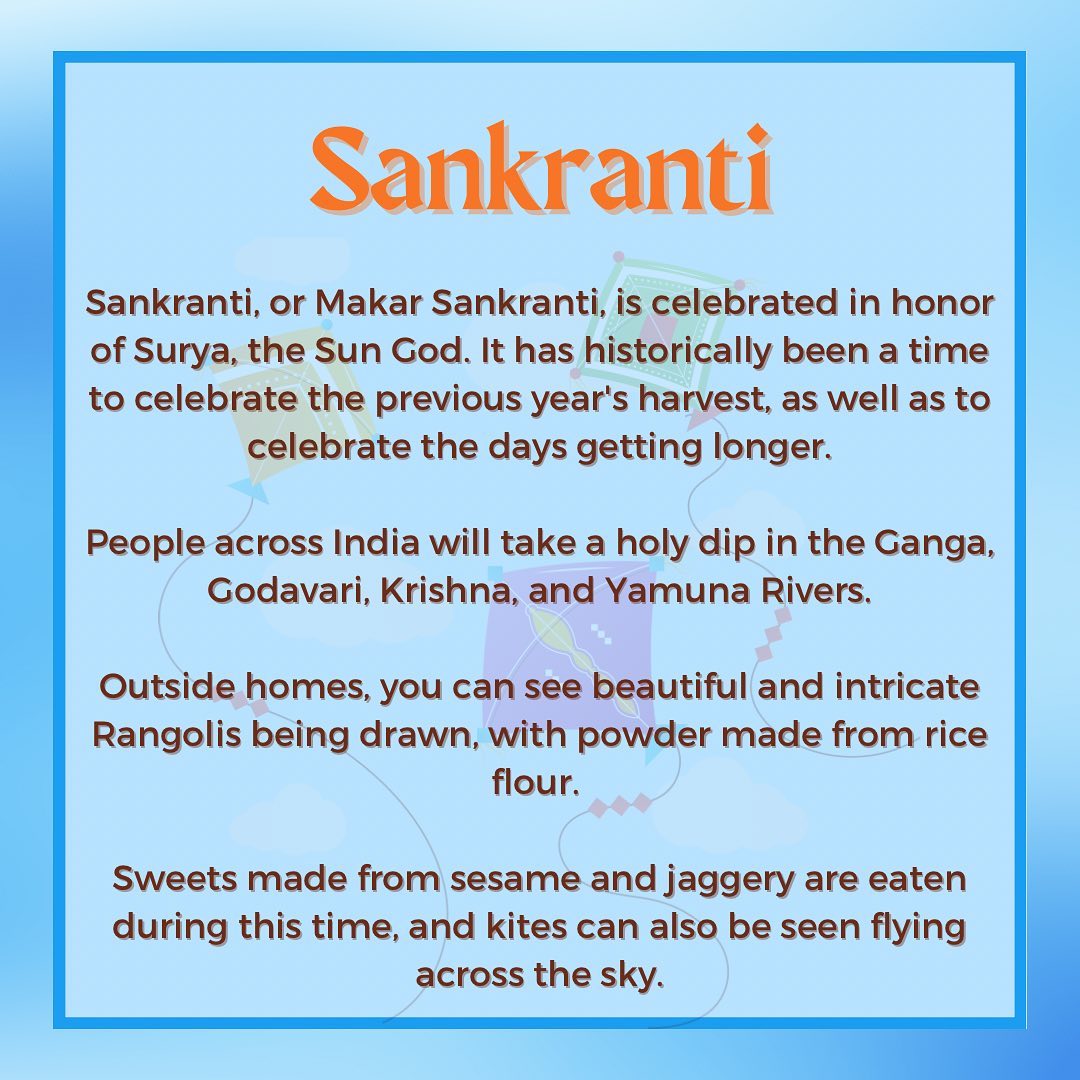
I have learned -Vitamin D is made by the body with sunlight.
Sesame seeds (til) have the highest calcium (975mg per 100g). Milk has 125mg only.
The body is capable of storing vitamin D up to a year, and use the reserves.
Lastly, the body is capable of getting its vitamin D reserves full with 3 full days of sunlight.
The best quality of sunlight is end of winter & beginning of summer.
Now join the dots, and see how wise our sages were in ancient India.
They created a festival of flying kites where by our kids get excited to go in the open, under direct sunlight, throughout the day starting from early morning. And their mothers feed them homemade TIL ladoos.
